library(sf)
library(terra)
library(tmap)
muni <- st_read("data/geodata.gpkg", "municipalities", quiet = TRUE)
obs <- read.csv("data/observations.csv")
obs <- st_as_sf(obs, coords = c("x", "y"), crs = "EPSG:2056")
soi <- st_as_sfc("POINT(2657271 1219754)", crs = "EPSG:2056")
elev <- rast("data/dem.tif")7 Static maps
Since a few years, it is possible to make really attractive maps using only R. For example, almost all the maps of the Swiss Breeding Bird Atlas 2013-16 were produced in R. Standard GIS software will obviously provide more advanced cartographic tools, such as advanced labeling and masking. Nonetheless R is good enough for most cases. Moreover you definitely have a big advantage in terms of reproducibility. In this part we will first look at how we can use sf and terra standard plotting functions to make simple maps. Then we’ll use the tmap package which massively simplify the creation of maps and also provides interesting tools to produce complex layouts.
7.1 Basic maps
As we’ve seen in some previous examples, the most basic way to make maps is simply to use the plot() function. Both sf and terra extend this function to support vector and raster data sets. Most of the standard arguments provided by the standard plot() function (such as main, pch, lwd, cex, etc.) are also supported. If you want to see all the additional parameters, you can check the help files (?sf::plot and ?terra::plot).
To plot sfc objects, we simply pass the object to the plot() function. To plot a specific attribute of an sf object, we need to add the name of the attribute inside square brackets. Here’s a simple example:
muni_sfc <- st_geometry(muni)
plot(muni_sfc)
plot(muni["name"], lwd = 2, main = "Municipalities")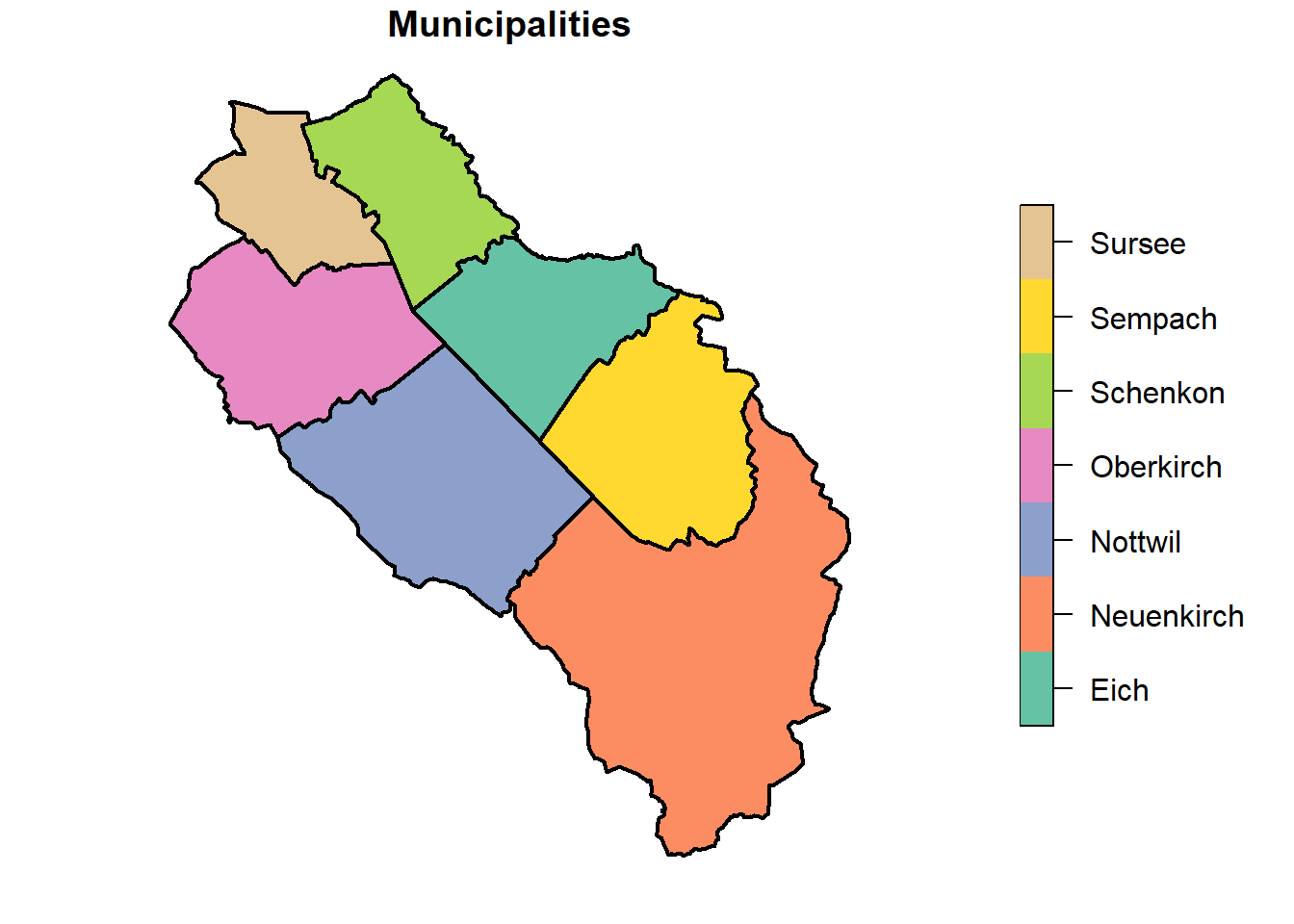
We can also plot several attributes simultaneously, but this will unfortunately remove the legend and we can’t use the main argument to add a global title. If you don’t specify any attribute, the first 10 will be plotted. Note that sf uses by default different color palettes for categorical and continuous variables.
plot(muni[c("name", "popsize")], lwd = 2)
Maps of polygons with some continuous attribute are called choropleth maps. These maps are often used to represent spatially variables such as population densities or per capita income. The number of breaks and the algorithm used to compute these breaks have a huge influence on the output map. Choose these settings carefully and be aware that they can dramatically change the interpretation of a map.
Let’s have a look at the population size of all the cantons in Switzerland:
cantons <- st_read("data/geodata.gpkg", "cantons", quiet = TRUE)
plot(cantons["popsize"])
If, like me, you’re not a big fan of the default colors used by sf, you can change the color palette thanks to the pal argument. You can use all the palettes available in R. You should especially have a look at the RColorBrewer and viridis packages. These were designed by color specialists and are highly recommended. For RColorBrewer you can visualize the existing color palettes on the following website: https://colorbrewer2.org. Note that some ColorBrewer and Viridis palettes are already included in the hcl.colors() color palette function (to see the full list, use hcl.pals()).
Guessing the number of colors you’ll need to use inside the color palette function can be a bit tricky (or at least I haven’t found a consistent way to make things easier). By default sf will create 10 evenly distributed breaks (using the pretty algorithm) and you’ll thus need 9 colors, but depending on the data and the chosen algorithm, this number can be different. If you’re not sure, just create a plot using the default colors and count the number of unique colors.
plot(cantons["popsize"], pal = hcl.colors(8, "Blues", rev = TRUE))
We can easily change the number of breaks using the nbreaks argument. Let’s reduce the number of breaks to see if this improves our map.
plot(cantons["popsize"], nbreaks = 5, pal = hcl.colors(4, "Blues", rev = TRUE))
Sometimes it’s better to use another algorithm to define the breaks, we can change this setting using the breaks argument. For example the quantile algorithm will ensure that each class has the same number of features (careful, these maps can often be misleading).
plot(cantons["popsize"], nbreaks = 5, breaks = "quantile", pal = hcl.colors(5, "Blues", rev = TRUE))
Of course it’s also possible to define our own breaks by passing a numeric vector with the actual breaks to the breaks argument. Don’t forget to also use the at argument in order to have a matching legend.
plot(cantons["popsize"], breaks = c(min(cantons$popsize), 200000, 500000, 1000000, max(cantons$popsize)), at = c(200000, 500000, 1000000), pal = hcl.colors(4, "Blues", rev = TRUE))
When we create maps, we usually consider the different data sets as layers that we combine to produce a nice output. This is why we will often use the add = TRUE argument in the plot() function.
plot(st_geometry(muni), col = "grey90", border = "grey50", lty = 3)
plot(st_union(muni), col = NA, border = "grey50", lwd = 2, add = TRUE)
plot(obs["name"], pch = 16, cex = 2, add = TRUE)
The map looks OK but we’re definitely missing a legend for the points. Adding such a legend is a bit tricky, we need to use a lookup table to match the species names and the colors inside the plot() function. This is, in my opinion, a good example of why specialized packages like tmap should be preferred.
obsColors <- data.frame(name = unique(obs$name), color = sf.colors(length(unique(obs$name)), categorical = TRUE))
plot(st_geometry(muni), col = "grey90", border = "grey50", lty = 3)
plot(st_union(muni), col = NA, border = "grey50", lwd = 2, add = TRUE)
plot(obs["name"], pch = 16, cex = 2, col = obsColors$color[match(obs$name, obsColors$name)], add = TRUE)
legend(x = "topright", legend = unique(obs$name), col = obsColors$color, pch = 16, bty = "n")
Plotting raster data is very similar, again use we use the plot() function.
plot(elev)
We get a continuous legend by default for continuous rasters, but we can easily use intervals with the breaks argument. This should be either a single number specifying the number of breaks or a vector with the actual breaks. The color palette can be changed using the col argument.
plot(elev, breaks = 10, col = hcl.colors(10, "Blues"))
And we can of course combine vector and raster data using layers like in the previous example.
plot(elev, breaks = 10, col = hcl.colors(10, "Blues"))
plot(st_geometry(muni), border = "white", lwd = 3, col = rgb(1, 1, 1, 0.4), add = TRUE)
You need to be extra cautious when using data sets with different CRSs. Let’s have a look at this example:
temp_poly <- st_buffer(soi, 2000000)
plot(st_geometry(World))
plot(temp_poly, col = "grey90", add = TRUE)
plot(st_transform(temp_poly, 4326), col = "grey90", add = TRUE)
The plot() function doesn’t understand CRSs. Our initial buffer (using EPSG:2056) will therefore not be placed correctly on the world map (using EPSG:4326). We first need to make sure that all data sets use a common CRS.
7.2 Basemaps
To help people understanding your maps, you’ll often need to add some kind of basemap such as a topographic map or aerial imagery. If you don’t have high quality basemaps at your disposal, you’ll need to use some online map provider such as OpenStreetMap. In this section we will see how to use the maptiles1 package to do this.
Creating a basemap and keeping it up to date is a lot of work! Please do not forget to cite it properly when you use some basemap.
When you browse an online map, even though everything looks like a single map, you are actually looking at many small tiles stitched together at a specific zoom level. The get_tiles() function allows us to download and merge these tiles. To specify the extent you want to download, you can use an sf or sfc object (SpatVector and SpatRaster are also working). The get_tiles() function will automatically use the bounding box of the object. You also need to specify the desired provider (use the get_providers() function to get a list of the available providers). The output will be a SpatRaster object with 3 bands (red, green and blue).
library(maptiles)
osm_basemap <- get_tiles(obs_in_sempach, provider = "OpenStreetMap", crop = TRUE)Warning: `lift()` was deprecated in purrr 1.0.0.
ℹ The deprecated feature was likely used in the slippymath package.
Please report the issue at
<https://www.github.com/milesmcbain/slippymath/issues>.plot(osm_basemap)
I recommend using crop = TRUE to get a basemap cropped to the bounding box of your object, otherwise you’ll get all the tiles that intersect the bounding box. If you need another zoom level, you can easily get it using the zoom argument.
osm_basemap <- get_tiles(obs_in_sempach, provider = "OpenStreetMap", crop = TRUE, zoom = 13)
plot(osm_basemap)
You’ve probably noticed that the resolution of the basemap is rather low. One reason is that the map is automatically reprojected to the CRS of the object defining the extent. As we saw earlier, reprojecting rasters imply some sort of resampling that will impact the rendering quality. We can solve this using project = FALSE inside the get_tiles() function. The CRS of the output raster will then be EPSG:3857 (Pseudo-Mercator).
osm_basemap <- get_tiles(obs_in_sempach, provider = "OpenStreetMap", project = FALSE, crop = TRUE)
plot(osm_basemap)
The quality is slightly better but we’re hitting the main problem of most online map providers, the resolution they use is not high enough for creating high quality maps. Fortunately some providers allow downloading tiles with a better resolution, such as all the basemaps provided by Carto and Stadia (note that you’ll need an API key to use Stadia).
carto_basemap <- get_tiles(obs_in_sempach, provider = "CartoDB.Voyager", project = FALSE, crop = TRUE)
plot(carto_basemap)
If you find the colored basemaps too disturbing, you can easily create black and white versions using the following trick. Note that we need to use plotRGB() instead of plot() because terra doesn’t properly recognize the RGB bands.
osm_bw = (osm_basemap[[1]] + osm_basemap[[2]] + osm_basemap[[3]])/3
plotRGB(rast(list(osm_bw, osm_bw, osm_bw)))
If you want to use another provider that is not included in maptiles, you can easily create a custom provider using the create_provider() function. Then you can use this new provider inside the get_tiles() function. Note that the provider has to provide tiles using EPSG:3857 (it will not work with other CRSs). In the next example, we create 3 providers to get maps and imagery from Swisstopo.
# Create a new provider
swisstopo_grey_prov <- create_provider(
name = "swisstopo_grey",
url = "https://wmts.geo.admin.ch/1.0.0/ch.swisstopo.pixelkarte-grau/default/current/3857/{z}/{x}/{y}.jpeg",
citation = "Background map © Swisstopo")
swisstopo_color_prov <- create_provider(
name = "swisstopo_color",
url = "https://wmts.geo.admin.ch/1.0.0/ch.swisstopo.pixelkarte-farbe/default/current/3857/{z}/{x}/{y}.jpeg",
citation = "Background map © Swisstopo")
swisstopo_ortho_prov <- create_provider(
name = "swisstopo_ortho",
url = "https://wmts.geo.admin.ch/1.0.0/ch.swisstopo.swissimage/default/current/3857/{z}/{x}/{y}.jpeg",
citation = "Background map © Swisstopo")
swisstopo_grey_basemap <- get_tiles(obs_in_sempach, provider = swisstopo_grey_prov, project = FALSE, crop = TRUE)
plot(swisstopo_grey_basemap)
swisstopo_color_basemap <- get_tiles(obs_in_sempach, provider = swisstopo_color_prov, project = FALSE, crop = TRUE)
plot(swisstopo_color_basemap)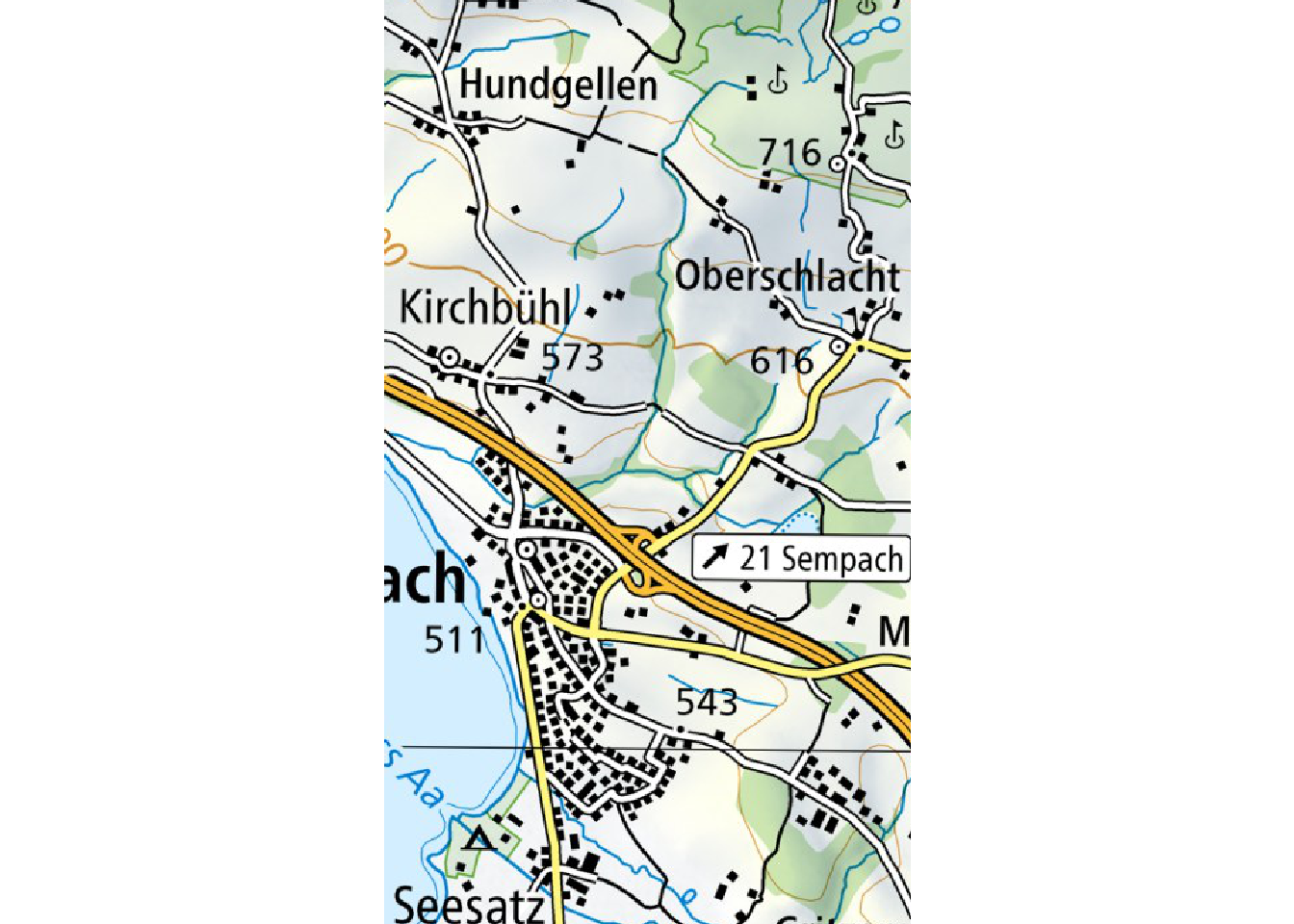
swisstopo_ortho_basemap <- get_tiles(obs_in_sempach, provider = swisstopo_ortho_prov, project = FALSE, crop = TRUE)
plot(swisstopo_ortho_basemap)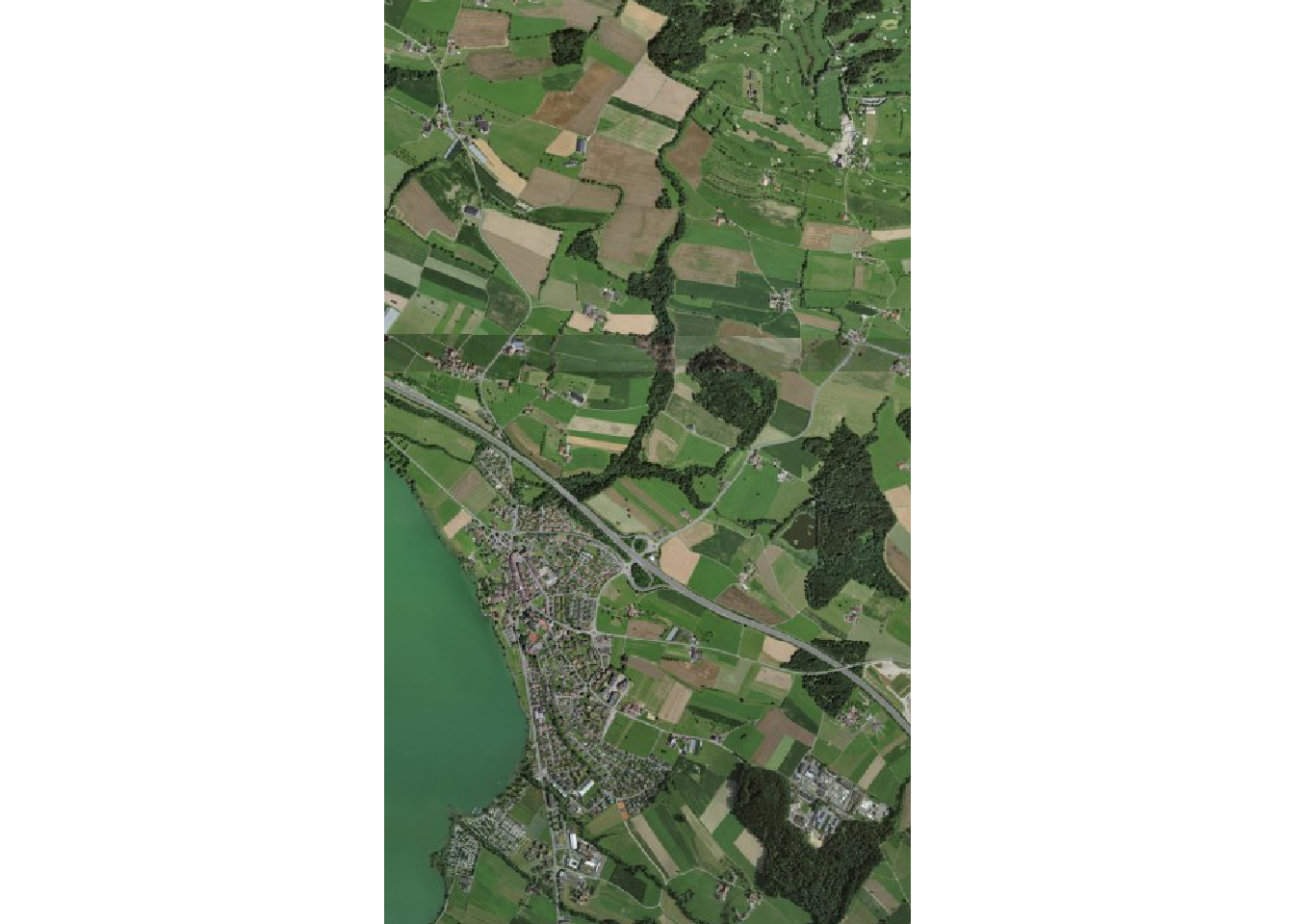
When using data from Swisstopo downloaded with maptiles, you will notice that the grid lines on the topographic maps won’t appear as straight perpendicular lines. This is caused by the reprojection of the original maps to EPSG:3857 on the Swisstopo server. The orthophotos also have some strange display artefacts.
We’ve already seen how to automatically crop the basemaps but sometimes you’ll need basemaps with an extent that is slightly bigger than the bounding box of your sf object. You can easily do that by using an affine transformation (see Section 5.11 for details). For example let’s make the bounding box 10% bigger:
bbox_sfc <- st_as_sfc(st_bbox(obs_in_sempach))
expanded <- (bbox_sfc - st_centroid(bbox_sfc)) * 1.1 + st_centroid(bbox_sfc)
st_crs(expanded) <- "EPSG:2056"
swisstopo_grey_basemap <- get_tiles(expanded, provider = swisstopo_grey_prov, project = FALSE, crop = TRUE, zoom = 14)
plot(swisstopo_grey_basemap)
points(st_transform(obs_in_sempach, "EPSG:3857"), col = "blue")
7.3 World maps and globes
As we’ve seen before, the default projection that is used to plot data with a geographic CRS is not ideal. The distortions are large (especially near the poles) and the map will appear elongated. If you want to plot world maps, I recommend using either the Robinson projection, which was designed to be aesthetically pleasing, or the Equal-Earth projection, which has the advantage of having equal areas. The Winkel tripel projection can also be a good choice. We need to include a graticule to display the limits of the world map.
grat <- st_geometry(st_graticule(lon = seq(-180, 180, by = 40), lat = seq(-91, 91, by = 30)))
plot(st_transform(st_geometry(World), "ESRI:54030"))
plot(st_transform(grat, "ESRI:54030"), col = "grey50", add = TRUE)
plot(st_transform(st_geometry(World), "EPSG:8857"))
plot(st_transform(grat, "EPSG:8857"), col = "grey50", add = TRUE)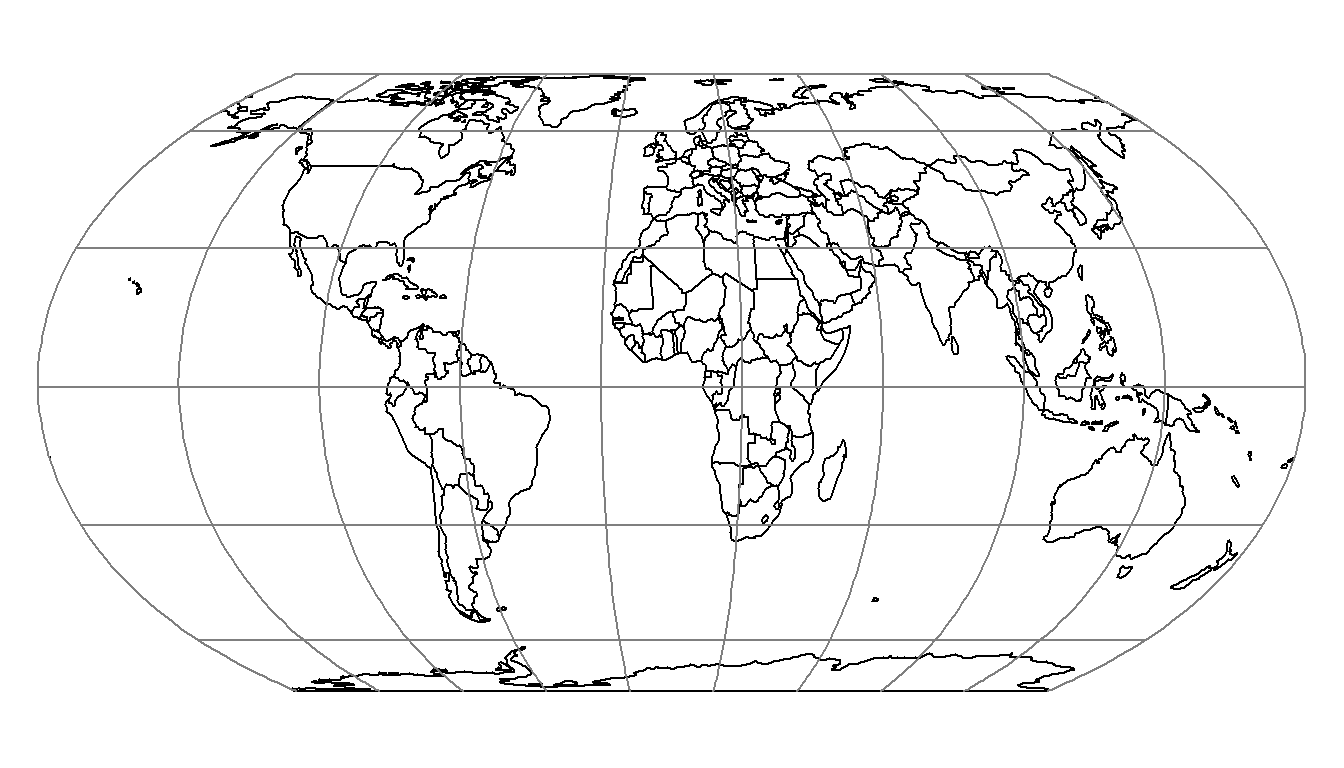
If you want to plot a 2D globe, you can use the orthographic projection. You can center the globe on one point by modifying the lat_center and lon_center variables in the following code.
library(s2)
options(s2_oriented = TRUE) # don't change orientation of the geometries (since the orientation is already correct)
lat_center <- 40
lon_center <- -10
earth <- st_as_sfc("POLYGON FULL", crs = "EPSG:4326")
# If you specify the first argument (x = earth), some lines will be missing after clipping
grat <- st_graticule(lon = seq(-180, 180, by = 20), lat = seq(-90, 90, by = 30))
countries <- st_as_sf(s2_data_countries())
oceans <- st_difference(earth, st_union(countries))
# Clip the data using the visible half (otherwise problems can happen with the orthographic projection, for example countries with vertices in the non-visible part will disappear)
buff <- st_buffer(st_as_sfc(paste0("POINT(", lon_center, " ", lat_center, ")"), crs = "EPSG:4326"), 9800000) # visible half
countries_clipped <- st_intersection(buff, countries)
oceans_clipped <- st_intersection(buff, oceans)
grat_clipped <- st_intersection(buff, grat)
projstring <- paste0("+proj=ortho +lat_0=", lat_center, " +lon_0=", lon_center)
plot(st_transform(oceans_clipped, projstring), col = "lightblue")
plot(st_transform(countries_clipped, projstring), col = NA, add = TRUE)
plot(st_transform(grat_clipped, projstring), col = "grey50", add = TRUE)
You probably remember my warning about proj4strings, and that you should not use them for projections. I’m actually using one of these strings here to define the orthographic projection. Fortunately, for global maps, the inaccuracies are negligible. Moreover, it is easier to define the latitude and longitude of origin.
7.4 Exporting high quality maps
Using the default R graphic device doesn’t always produce good quality maps, especially if you need to use them for publications. If you want high quality maps you can use the PNG cairo graphic device. If you’re producing maps containing orthophotos or topographic maps, you should use the JPEG cairo device instead.
png("export/map.png", width = 4200, height = 3000, res = 300, type = "cairo")
plot(st_geometry(muni), col = "grey90", border = "grey50", lty = 3)
plot(st_union(muni), col = NA, border = "grey50", lwd = 2, add = TRUE)
plot(obs["name"], pch = 16, cex = 2, add = TRUE)
dev.off()When you include topographic maps or orthophotos in you maps, you might get disappointing results. By default, terra is using 500000 pixels to plot your map. If one of the layers has more pixels, terra will randomly sample them which can give the impression of a poor resolution. You can increase this number by using the maxcell argument. Be ready to wait a bit if you use really high values (small tip: to get the maximal resolution, use Inf).
par(mfrow = c(1, 2))
plot(ortho, maxcell = 10000)
plot(ortho, maxcell = Inf)
7.5 Swiss map with hillshade
If you need a nice Swiss map, you can use the following data and code snippet. The data and the hillshade were produced by Swisstopo and you should add the copyright if you use them. Note how the hillshade is customized and how the rivers get larger.
# Import cartographic elements
lakes <- st_read("data/swiss_carto.gpkg", "lakes", quiet = TRUE)
rivers <- st_read("data/swiss_carto.gpkg", "rivers", quiet = TRUE)
border <- st_read("data/swiss_carto.gpkg", "border", quiet = TRUE)
# Define the width of the rivers which will be used on the maps (rescale the attribute "thickness" between 0.5 and 2)
riverswidth <- as.numeric(gsub("[^0-9.]", "", rivers$thickness))
width_std <- (riverswidth - min(riverswidth)) * (2 - 0.5) / (max(riverswidth) - min(riverswidth)) + 0.5
# Import hillshade (copyright swisstopo)
hillshade <- rast("data/hillshade.tif")
# Crop hillshade with the extent of Switzerland (add a small buffer to avoid clipping the map in some places)
hillshade <- crop(hillshade, ext(st_union(border, lakes)) + 2000)
# Mask hillshade
hillshade <- mask(hillshade, border)
# Plot
plotRGB(hillshade, alpha = 0.7, smooth = TRUE, mar = c(1, 1, 1, 1), axes = FALSE, legend = FALSE, maxcell = Inf)
plot(st_geometry(border), col = NA, border = rgb(130, 130, 130, maxColorValue = 255), add = TRUE, lwd = 3)
plot(st_geometry(rivers), col = rgb(69, 138, 230, maxColorValue = 255), add = TRUE, lwd = width_std)
plot(st_geometry(lakes), col = rgb(162, 197, 243, maxColorValue = 255), border = rgb(69, 138, 230, maxColorValue = 255), add = TRUE)
7.6 tmap
If you want to make more complex maps, you can still achieve almost everything using standard plotting procedures but you’ll spend a lot of time trying to hack everything. If you’re a ggplot2 user, you can of course use it with spatial data. However there’s another package, tmap, that is similar to ggplot2 but more intuitive for maps and more GIS friendly. The tmap package is also based on the grammar of graphics approach that separates data and aesthetics.
This tutorial was written for tmap version 4.x. It will not work with older versions of tmap.
7.6.1 Mapping layers
To create a map with tmap, you first need to specify the data set you want to plot with the tm_shape() function. This function will accept the usual spatial objects created by sf and terra (and stars). Then you need to tell tmap how to represent the data using specific map layer functions (e.g. tm_polygons(), tm_dots()). An example should make things a bit clearer.
tm_shape(muni) + tm_polygons()
To adapt the symbology (color, line width, etc.) of the layers, we can specify visual variables (also called aesthetic mappings) inside the map layer functions. For polygons (and points), we use the fill variable to change the fill color of the features and the col variable to change the border color. You can also specify opacity with the variables fill_alpha and col_alpha. For line width and type, we use the standard lwd and lty variables. For lty you can use either a number from 0 to 6 or the corresponding character strings: blank, solid, dashed, dotted, dotdash, longdash or twodash).
tm_shape(muni) + tm_polygons(fill = "lightgreen", col = "darkgreen", lwd = 2, lty = "dotted")
Until now we only had one layer for one data set, but one data set can easily be represented by several layers. We simply need to add other map layer functions. Let’s improve the previous example by adding centroids and labels for each municipality (the ymod variable is adding a vertical offset).
tm_shape(muni) + tm_polygons() + tm_dots(size = 1.5) + tm_text("name", ymod = 1, col = "navy")
One nice feature of the package is that you can save map objects and modify them later
map1 <- tm_shape(muni) + tm_polygons()
map1 + tm_dots(size = 1.5) + tm_text("name", ymod = 1, col = "navy")
If you want to plot several data sets on the same map, you need to use tm_shape() for each data set. Of course, you will also need to use at least one map layer function for each object inside a tm_shape() function to define how the data will be plotted.
tm_shape(muni) + tm_borders(col = "black", lwd = 2) +
tm_shape(streets) + tm_lines(col = "grey50", lwd = 0.5) +
tm_shape(obs) + tm_dots(size = 0.4, fill = "navy")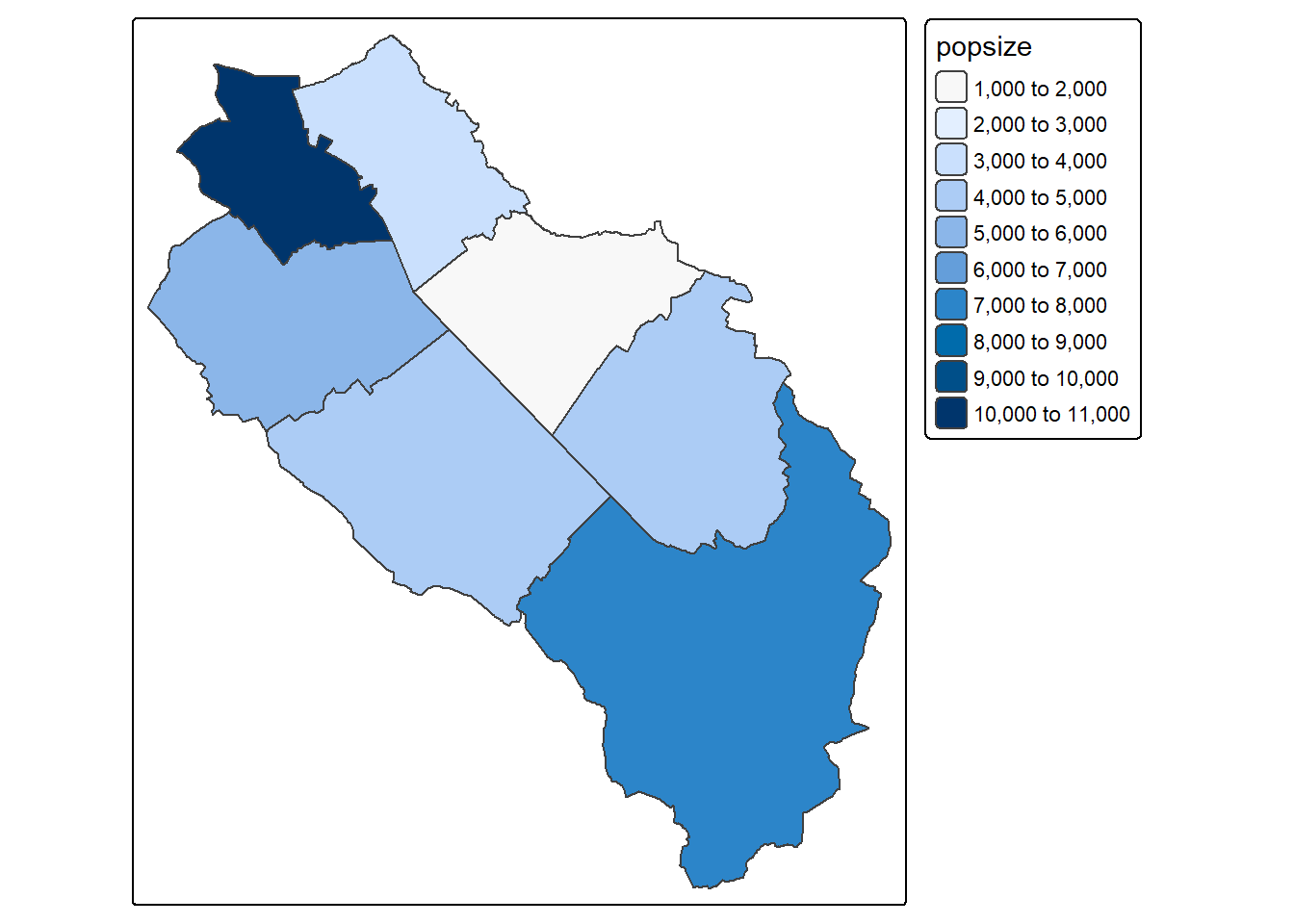
By default, tmap is using the first tm_shape() function to define the extent (and the CRS) of the map. It will referenced as the “main” shape. If you need to define your extent using another data set, you can add the is.main = TRUE argument to the desired tm_shape() function.
tm_shape(sempach) + tm_polygons() + tm_shape(obs) + tm_dots()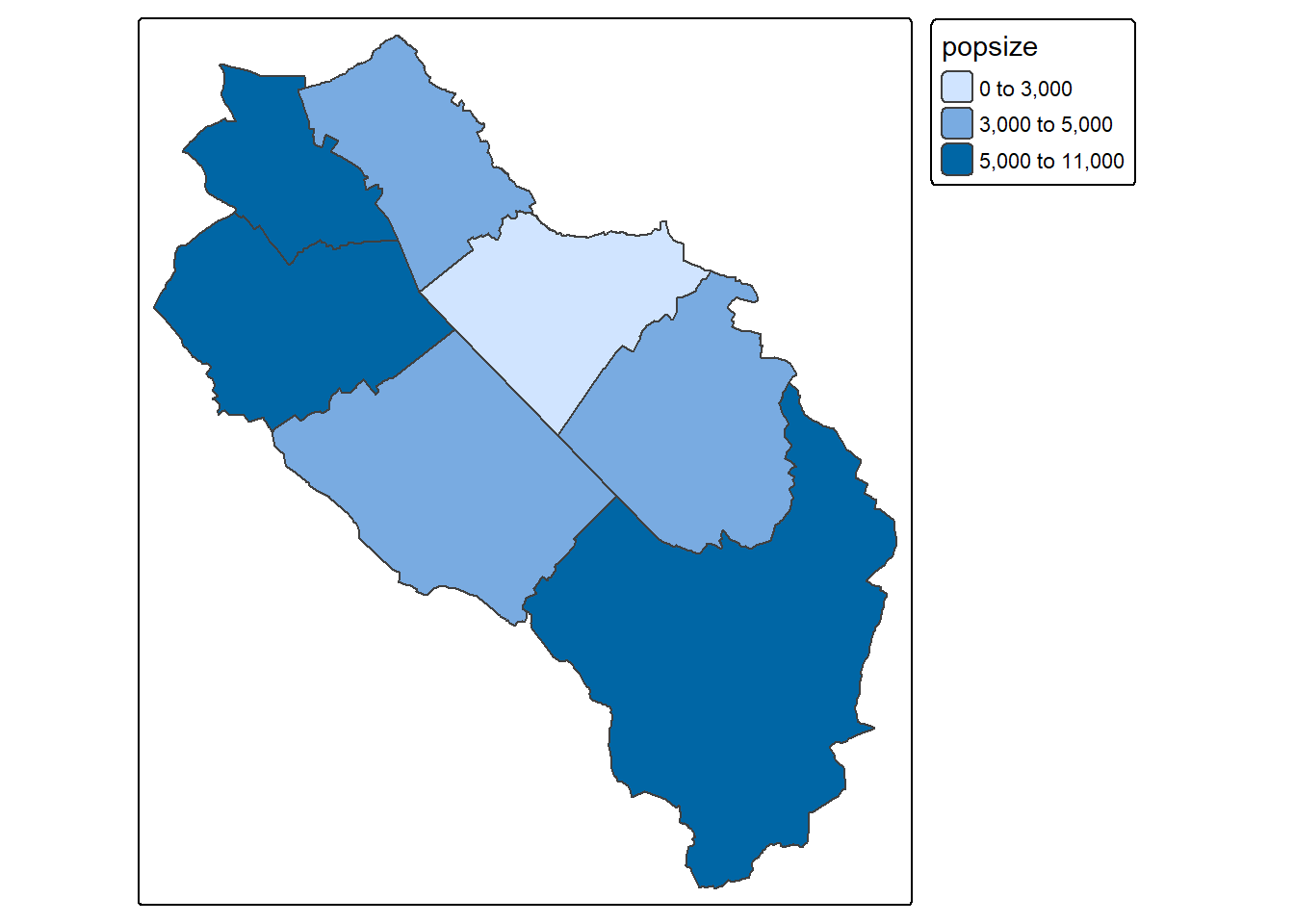
tm_shape(sempach) + tm_polygons() + tm_shape(obs, is.main = TRUE) + tm_dots()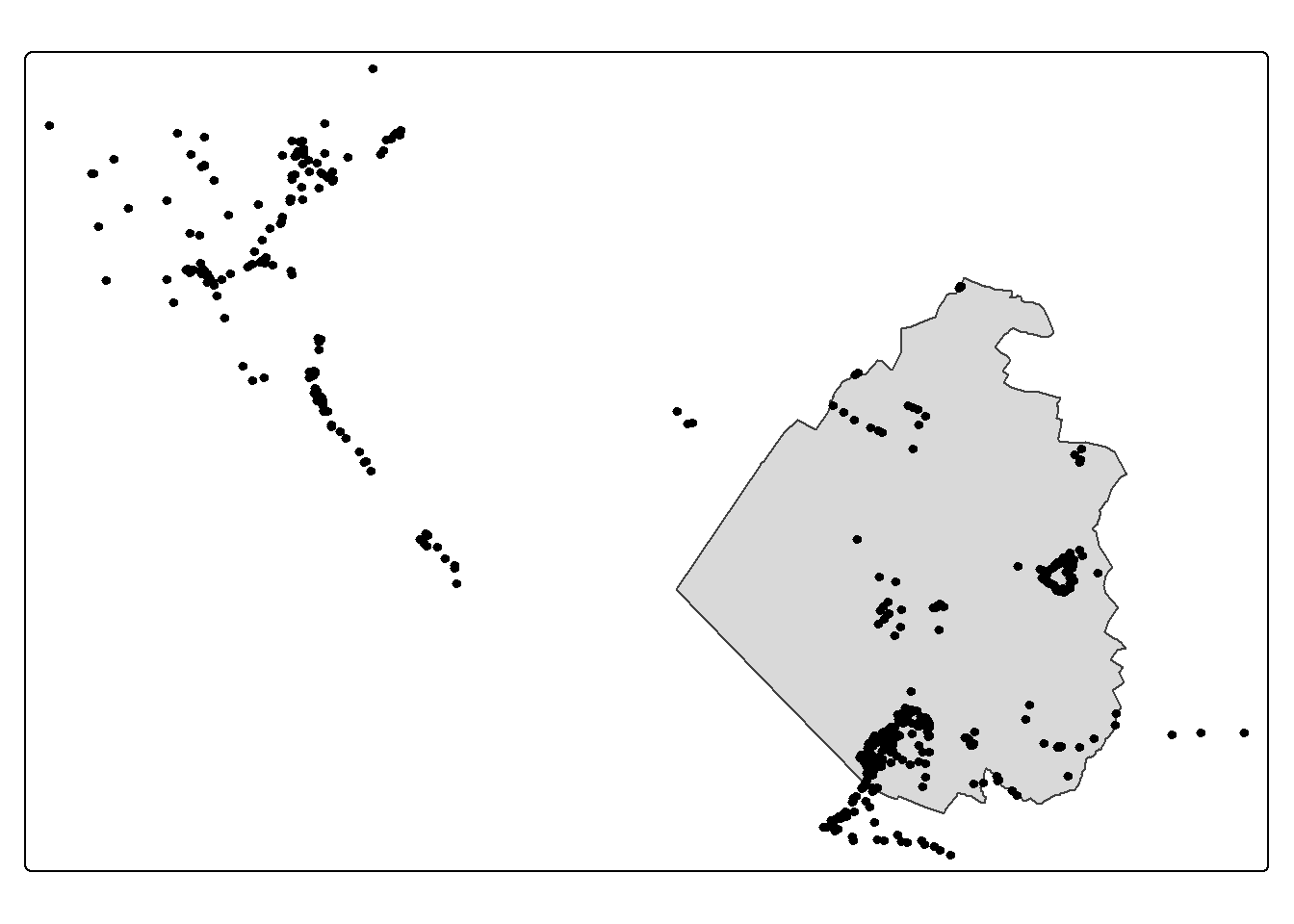
If your spatial objects are using different CRSs, tmap will use the CRS of the object inside the first tm_shape() function to draw the map and automatically reproject the data sets used in the following tm_shape() functions.
tm_shape(World) + tm_polygons() + tm_shape(st_buffer(soi, 2000000)) + tm_borders(col = "red", lwd = 2)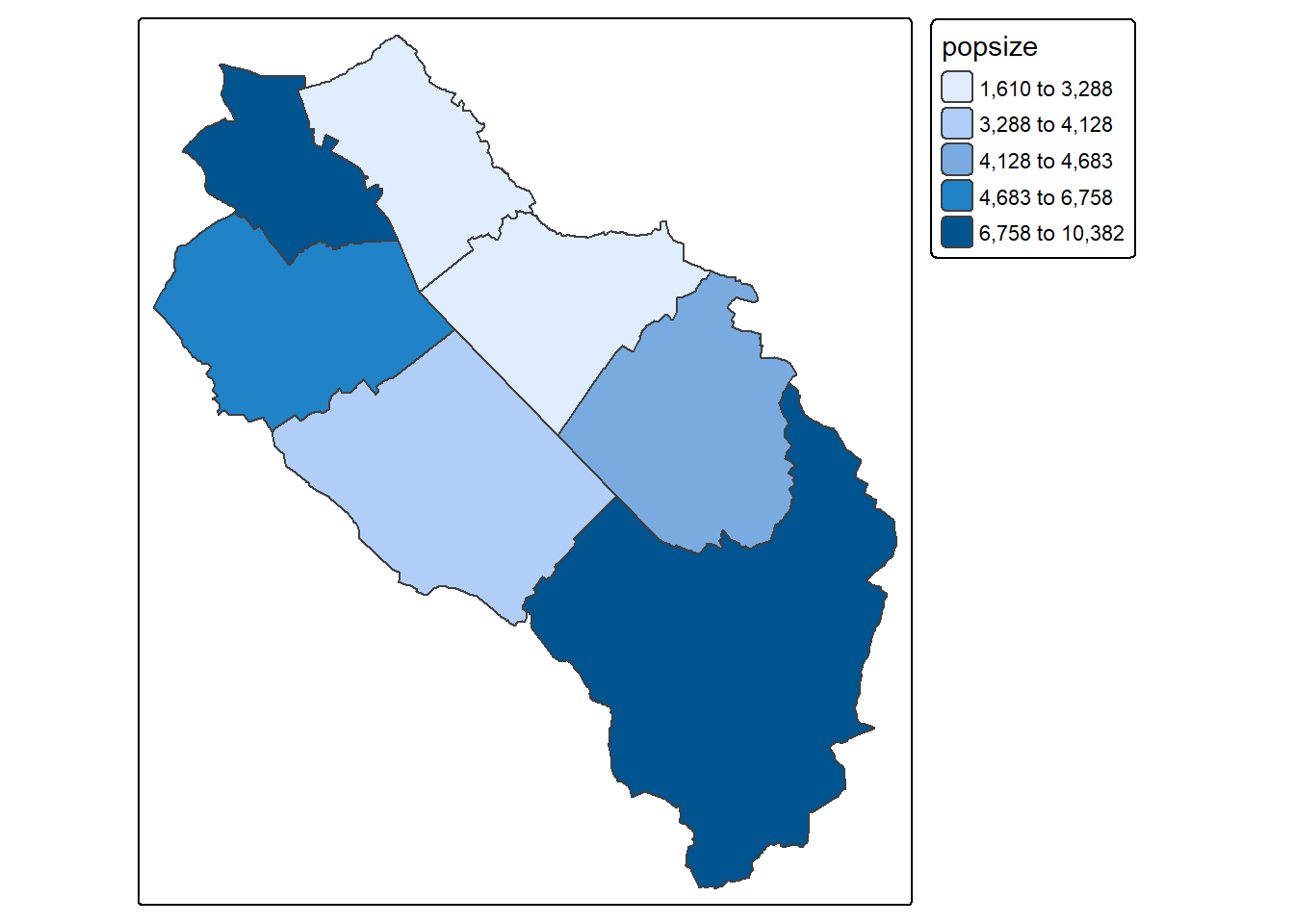
We’re not limited to vector data, tmap can easily plot SpatRaster objects (and also rasters coming from the stars package). We just need to combine tm_shape() with tm_raster() or tm_rgb() if you have RGB multiband rasters. Internally tmap is using the stars package to process rasters, therefore an internal conversion is happening for SpatRaster objects. By default rasters will be classified, if you want a continuous map, you can add the col.scale = tm_scale_continuous() argument to the tm_raster() function. You can of course combine vector and raster data.
tm_shape(elev) + tm_raster()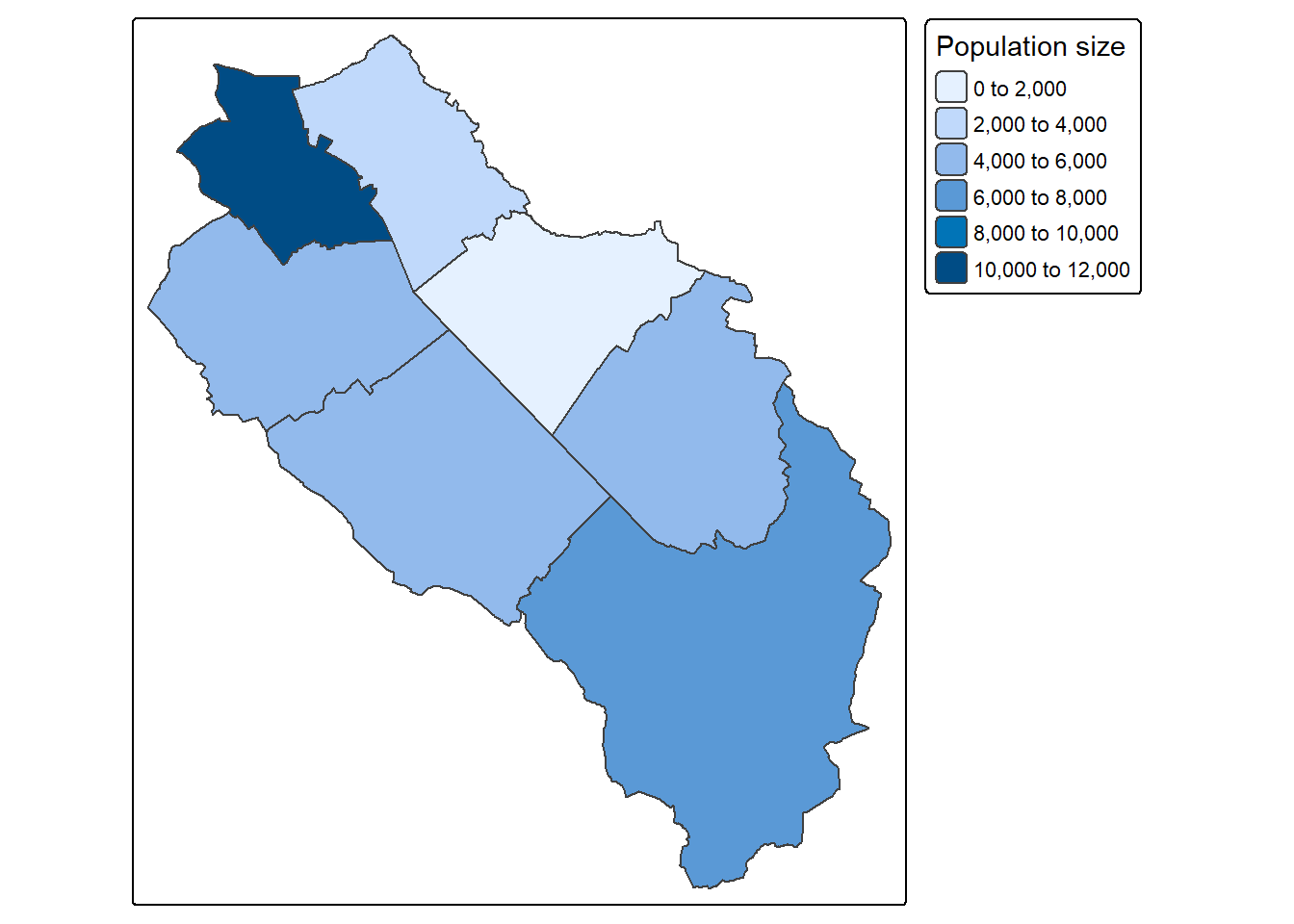
tm_shape(elev) + tm_raster(col.scale = tm_scale_continuous())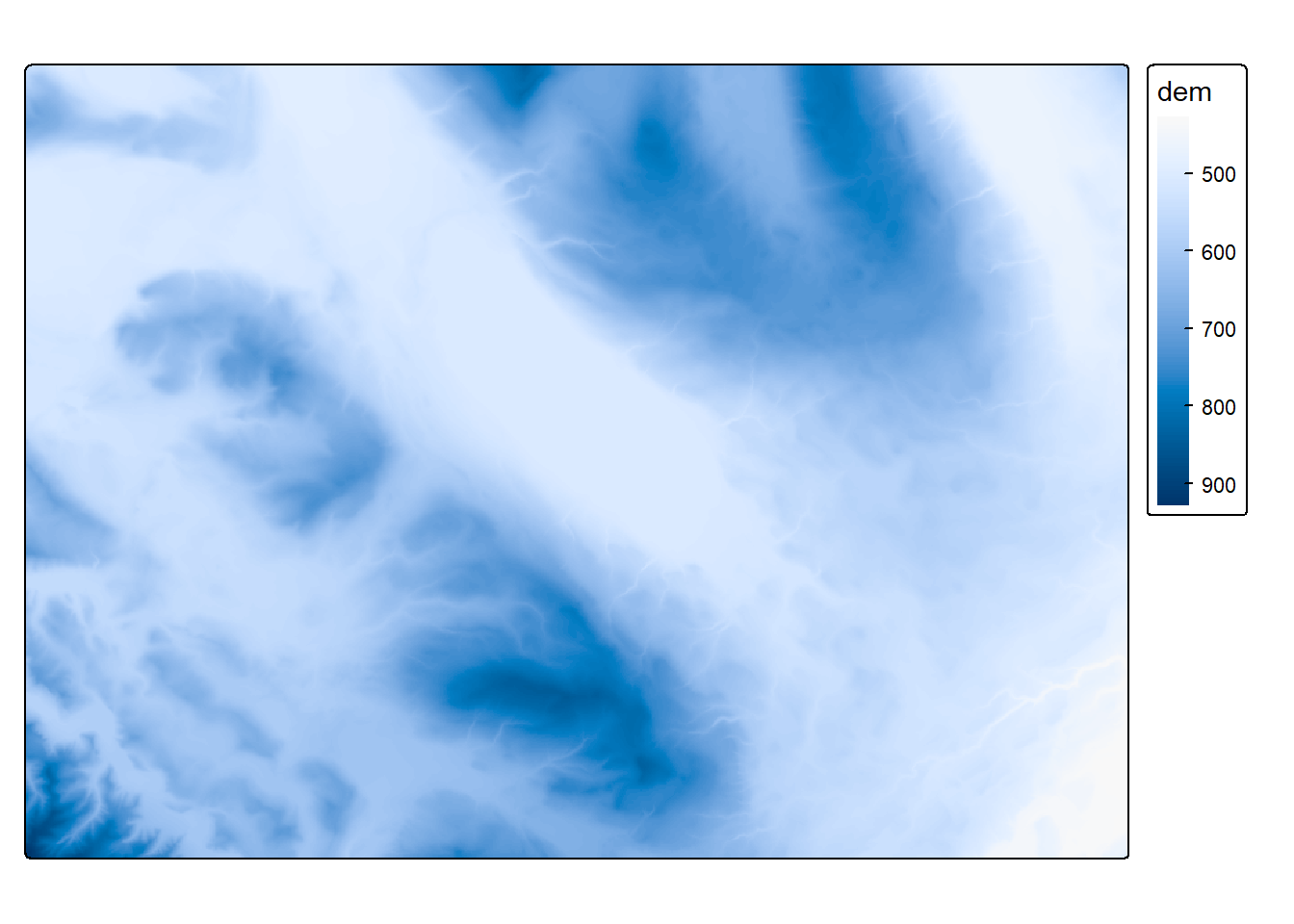
If you have a large raster, tmap will downsample it to gain speed. If you need the full resolution, you can change the raster.max_cells option using the tmap_options() function (this will stay like this until you close R or change the option again).
tmap_options(raster.max_cells = 10000)
tm_shape(ortho) + tm_rgb()SpatRaster object downsampled to 85 by 119 cells.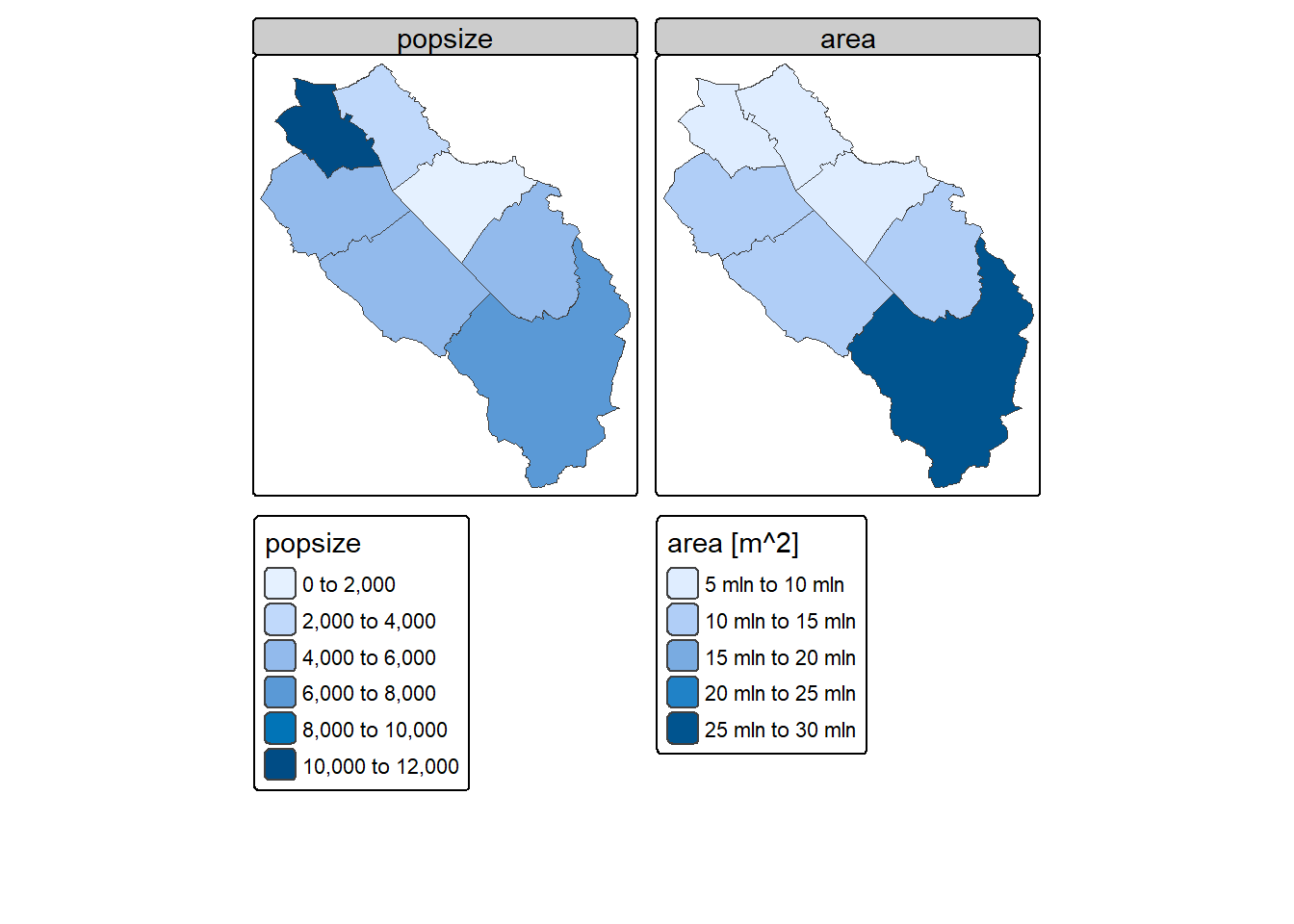
tmap_options(raster.max_cells = Inf)
tm_shape(ortho) + tm_rgb()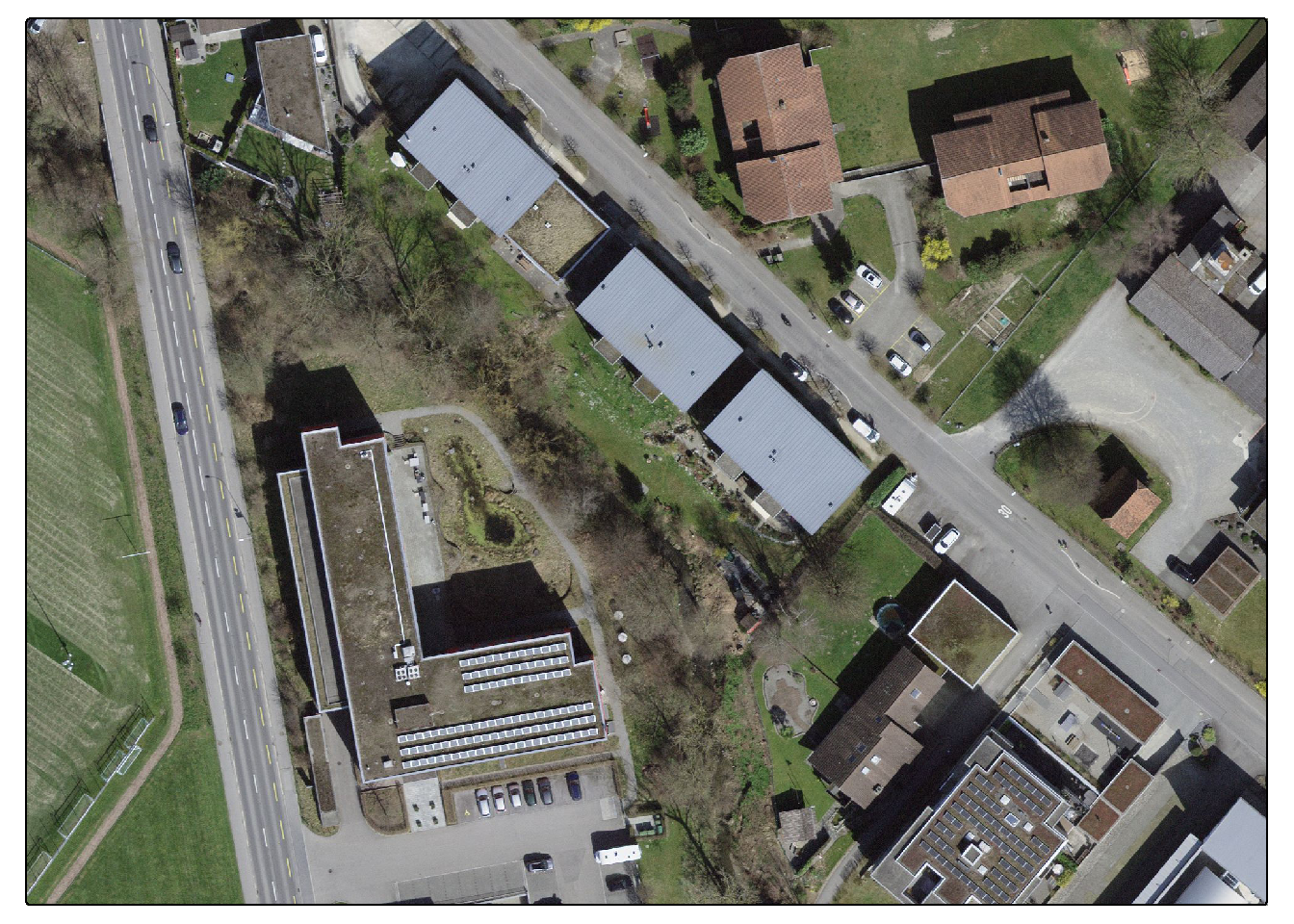
The tmap package is extremely powerful and allows making complex maps. However the number of options is really large and it is easy to feel a bit lost. Fortunately tmap also provides the qtm() function for quick mapping with sensible defaults. You can also combine data sets with repeated qtm() calls.
qtm(muni)
qtm(muni) + qtm(obs, fill = "navy")7.6.2 Choropleth maps
Producing a choropleth map is extremely easy with tmap. You just need to specify the attribute name inside the tm_polygons() function using the fill argument. This is called a data variable. The legend is automatically added.
tm_shape(muni) + tm_polygons(fill = "popsize")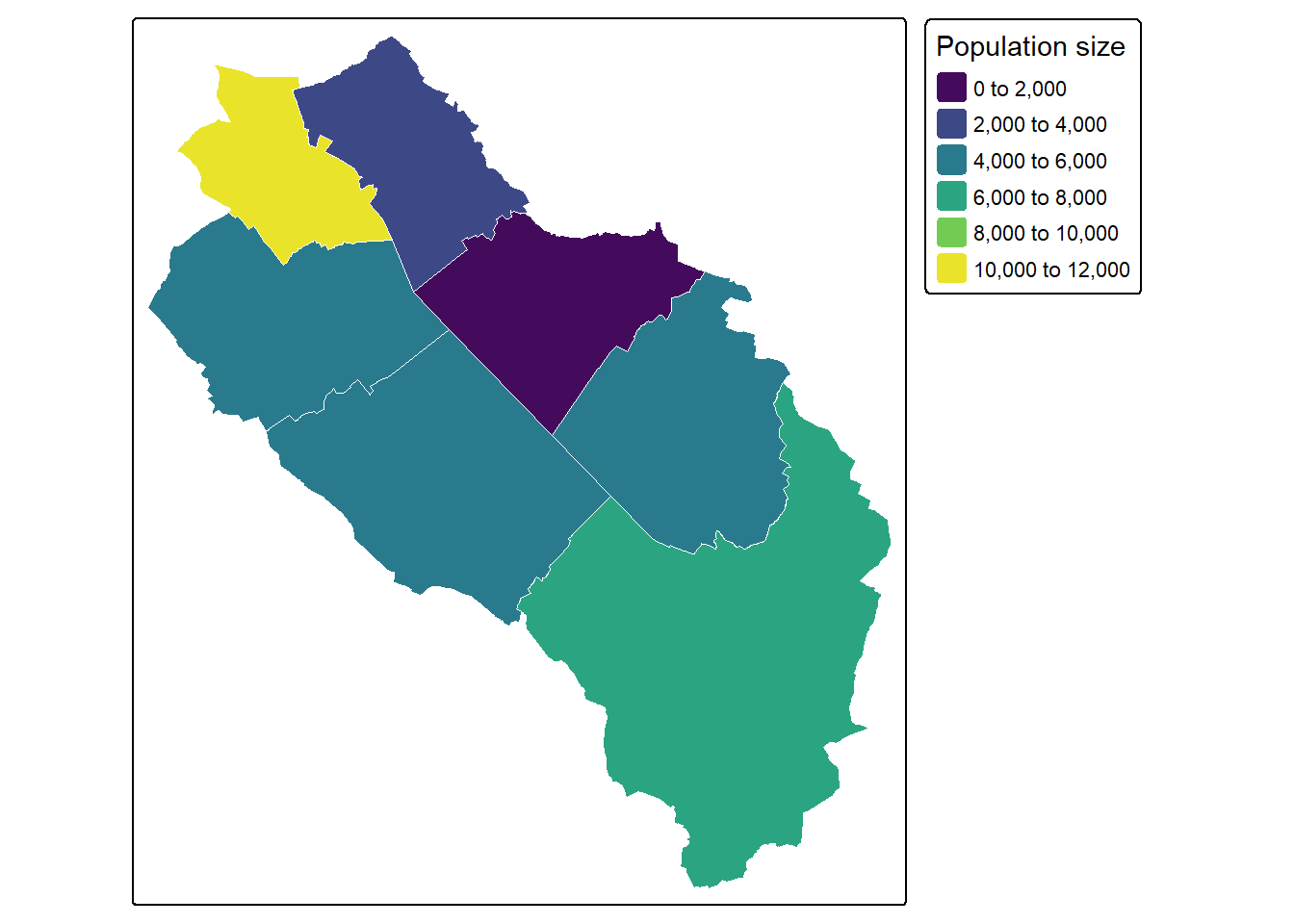
Changing the classification method is also possible by changing the scale of the visual variable (not to be confused with the scale of the map). In this context, a scale defines how to map the data values to visual values. Since you want to change the fill color of the polygons, you need to use the fill.scale argument. This argument expects a function that will tell tmap how to map the data. Here we use the generic tm_scale() function which will automatically choose an appropriate scaling function based on the data type and the visual variable. The most important scaling functions are: intervals (tm_scale_intervals()), continuous values (tm_scale_continuous()) and categorical values (tm_scale_categorical() and tm_scale_ordinal()). A lot more are available… If you already know which scaling function you need, I’d recommend using the appropriate one directly, instead of relying too much on tm_scale().
You can for example change the number of breaks used for the color fill with the n argument.
tm_shape(muni) + tm_polygons(fill = "popsize",
fill.scale = tm_scale(n = 10))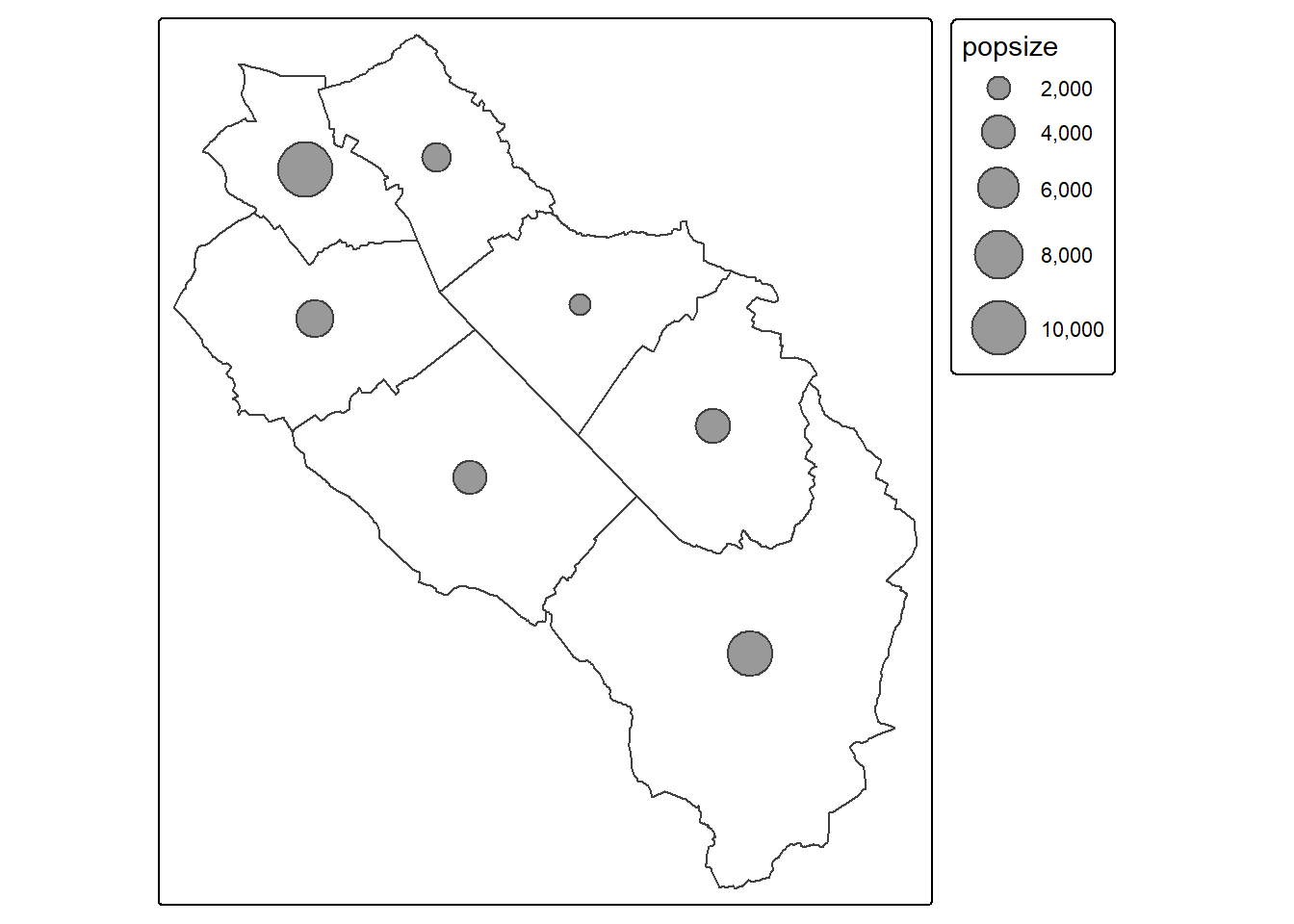
You can also specify the breaks manually with the breaks argument.
tm_shape(muni) + tm_polygons(fill = "popsize",
fill.scale = tm_scale(breaks = c(0, 3000, 5000, 11000)))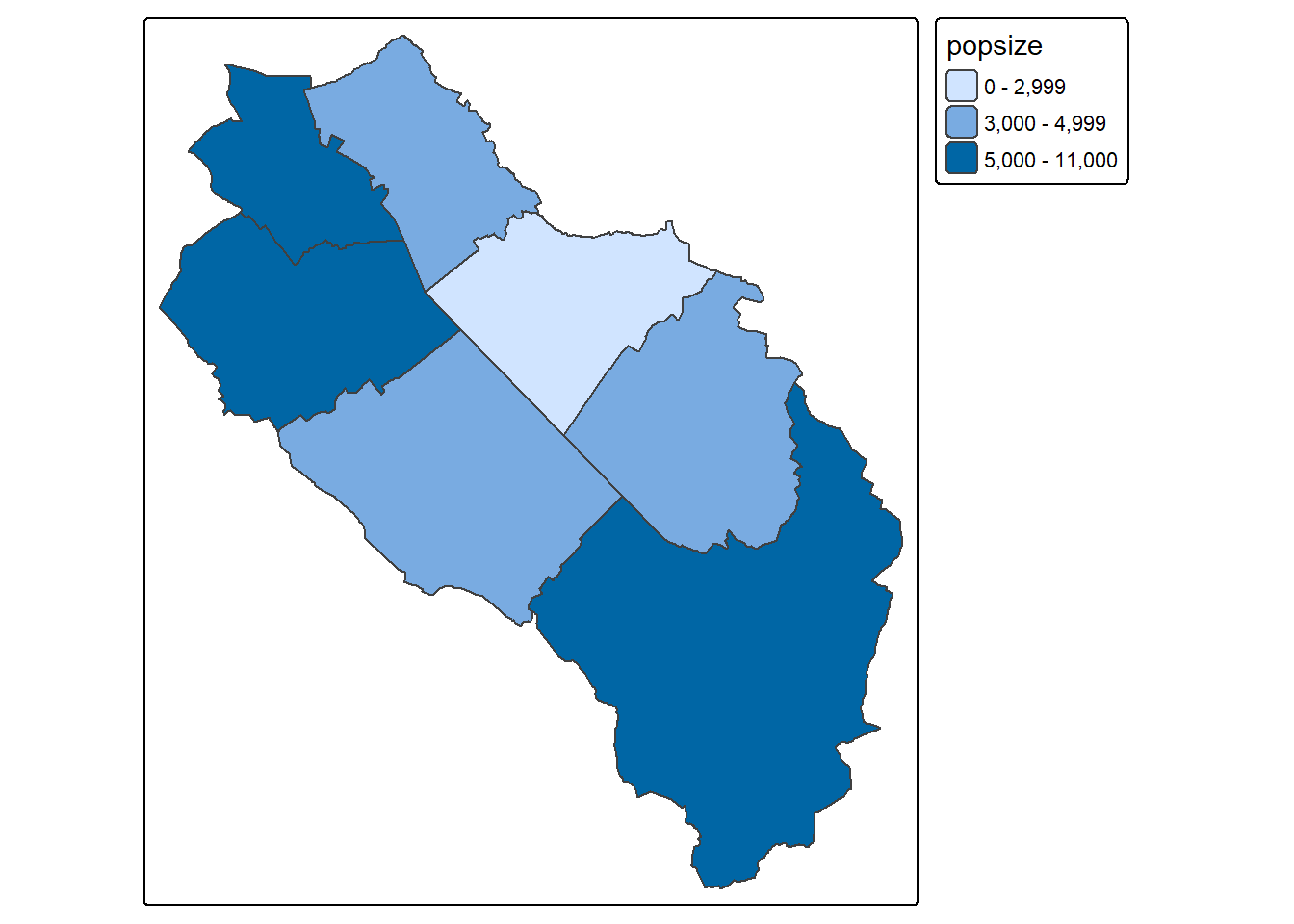
It is of course also possible to change the algorithm used to define the breaks by changing the style argument inside the scaling function. By default tmap uses the pretty algorithm but you can also use quantile, equal, sd, log10_pretty and many more.
tm_shape(muni) + tm_polygons(fill = "popsize",
fill.scale = tm_scale(style = "quantile"))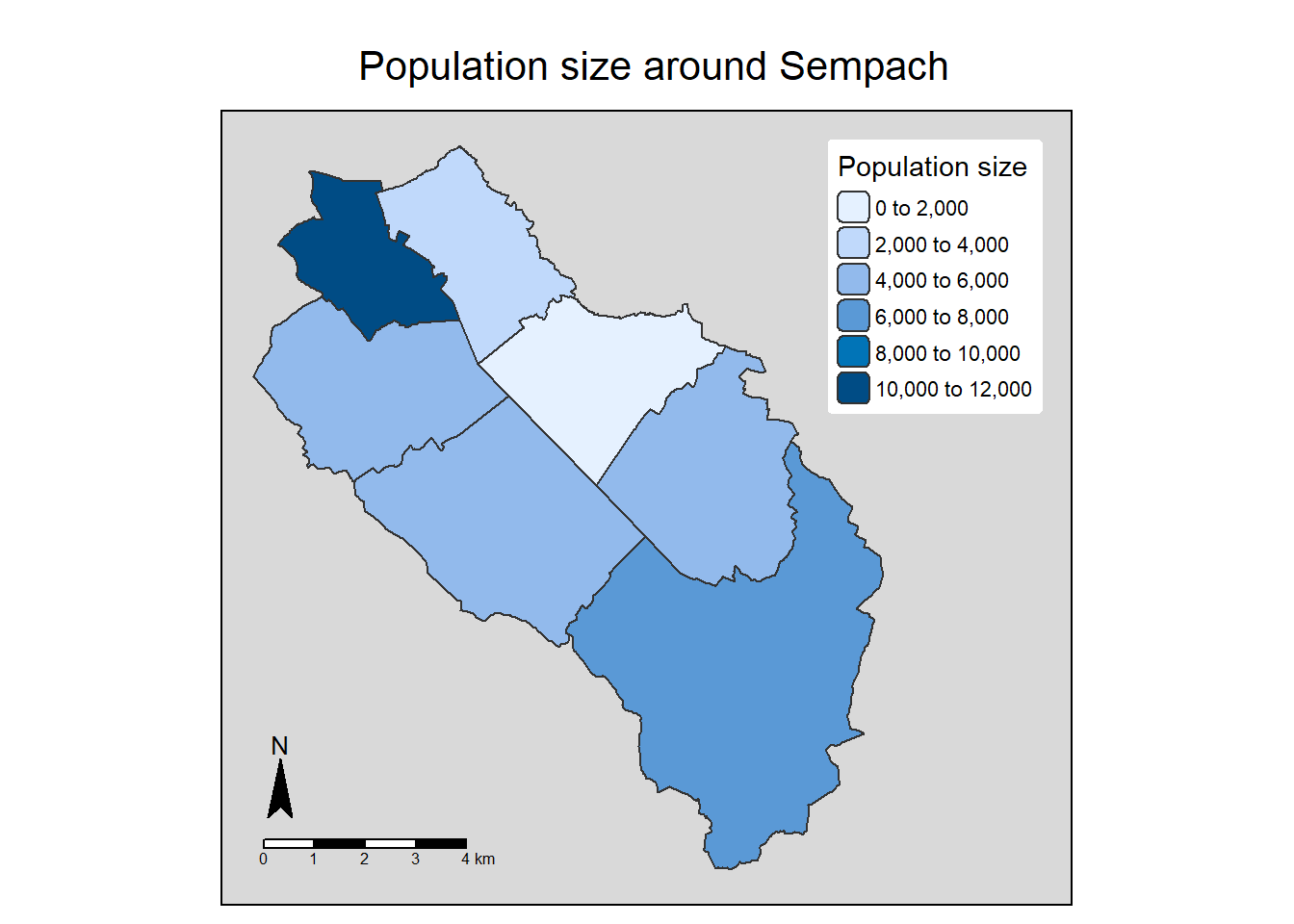
The logic is similar if you want to modify the legend. Since you want to modify the legend for the fill color, you need to use the fill.legend argument. This argument expects a function that will tell tmap how to draw the legend. Here we use the tm_legend() function, the first argument is the legend title.
tm_shape(muni) + tm_polygons(fill = "popsize",
fill.legend = tm_legend("Population size"))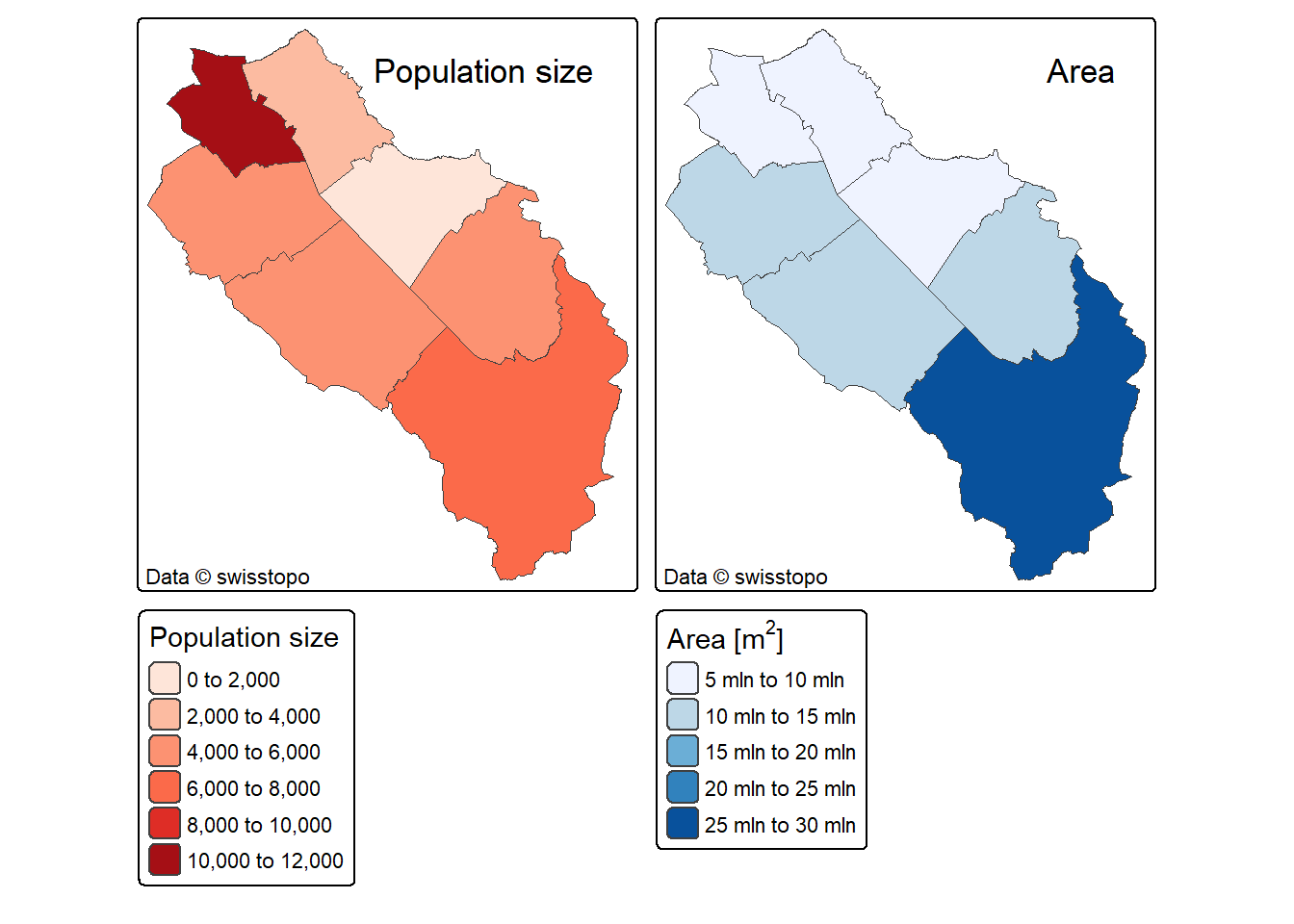
You can easily map several attributes in the same plotting window.
muni$area <- st_area(muni)
tm_shape(muni) + tm_polygons(fill = c("popsize", "area"))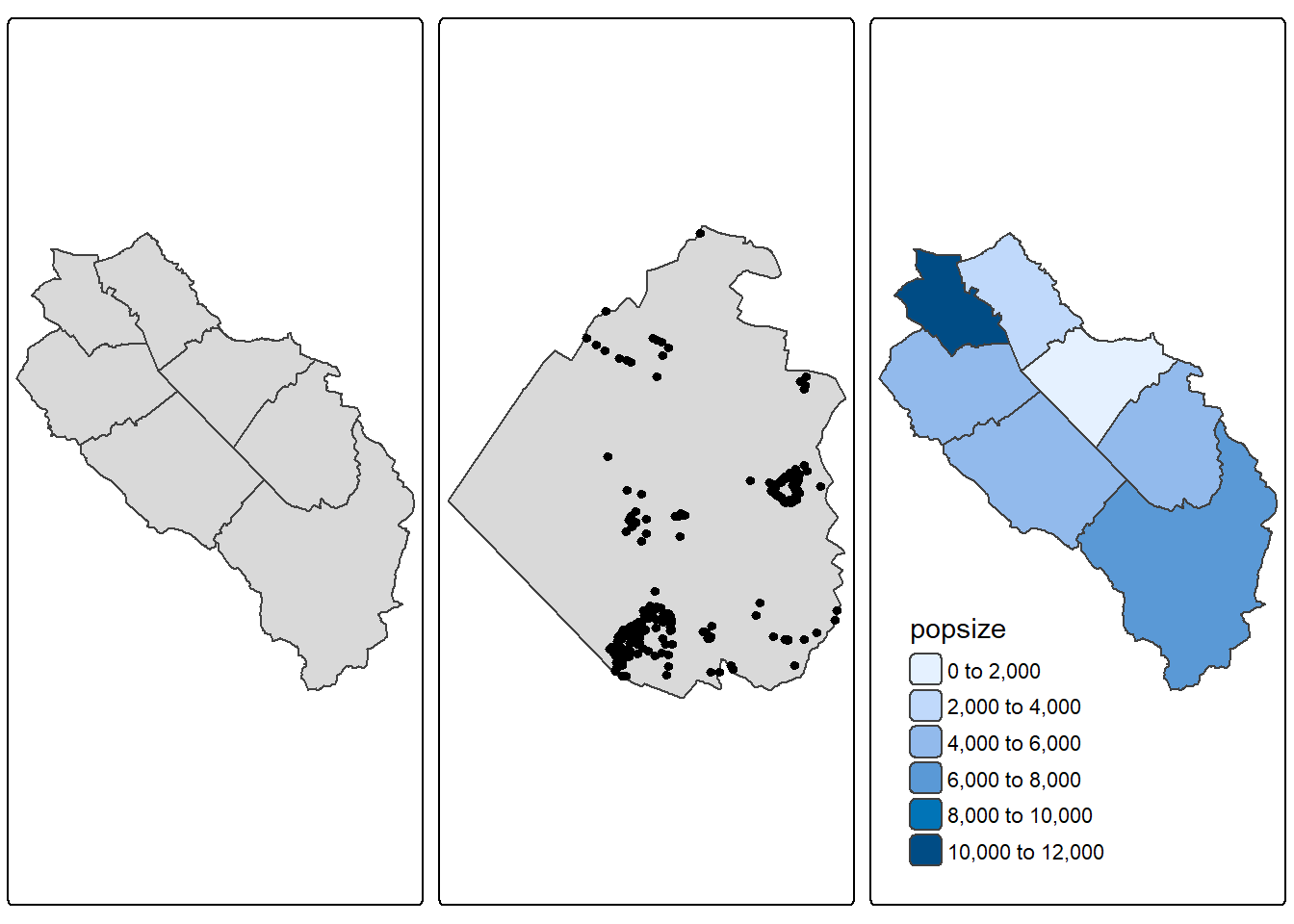
The default color palettes used by tmap are quite good but sometimes they won’t be appropriate. As we’ve seen earlier, the RColorBrewer and viridis packages provide really good color palettes. The cols4all2 package provides a nice function to visualize most of the palettes available in tmap: c4a_gui()
cols4all::c4a_gui()Changing the color fill is a bit different with choropleth maps since the fill variable is already used by the attribute name. With tmap, you do that inside the scaling function using the values argument (the name of this argument is a bit confusing in this case, but do not forget that scaling functions are also used for other visual variables such as line type or width). You can easily reverse the color palette by putting a - in front of the palette name.
tm_shape(muni) + tm_polygons(fill = "popsize",
fill.scale = tm_scale(values = "viridis"),
fill.legend = tm_legend("Population size"),
col = "white", lwd = 0.5)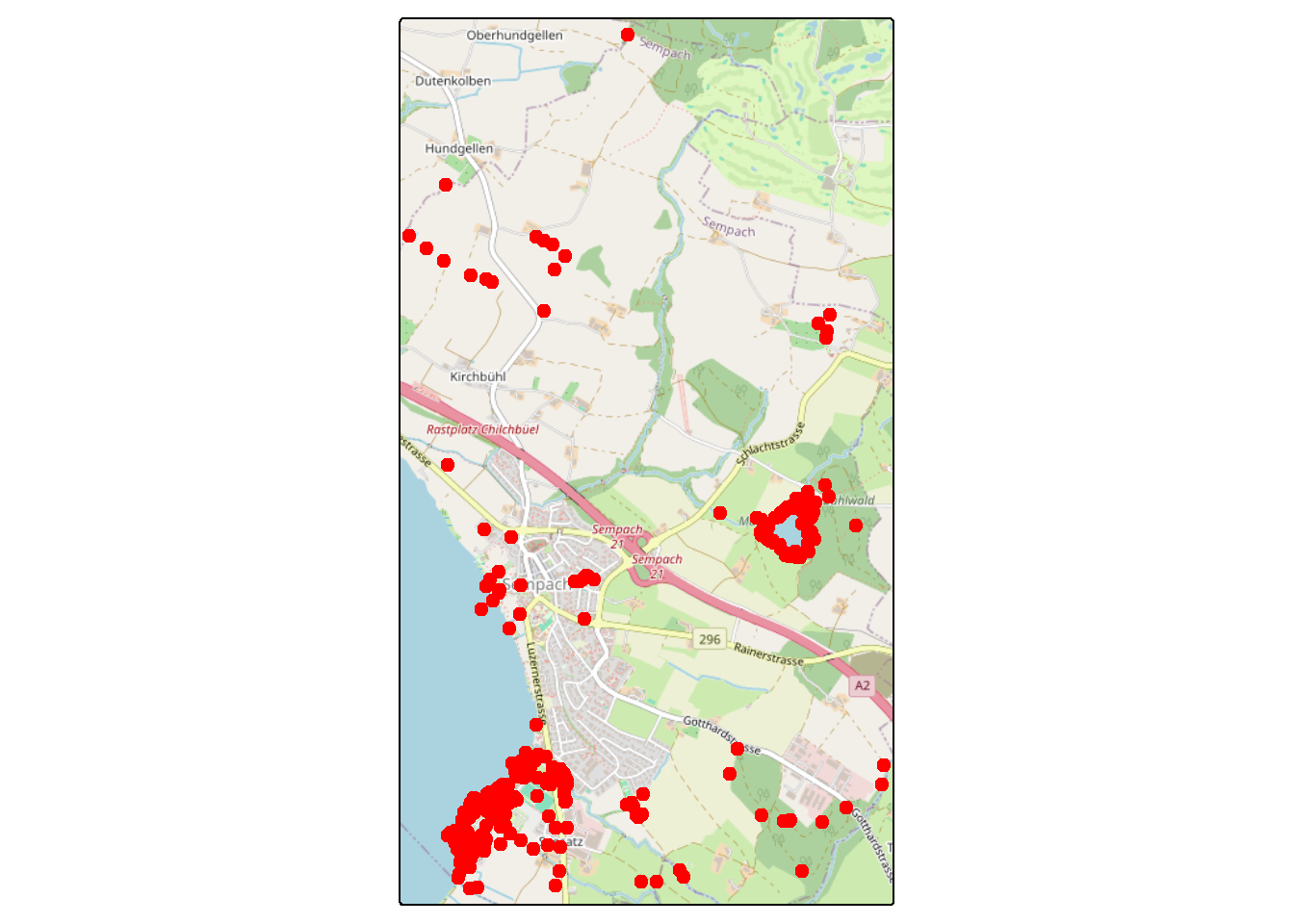
tm_shape(muni) + tm_polygons(fill = "popsize",
fill.scale = tm_scale(values = "-viridis"),
fill.legend = tm_legend("Population size"),
col = "white", lwd = 0.5)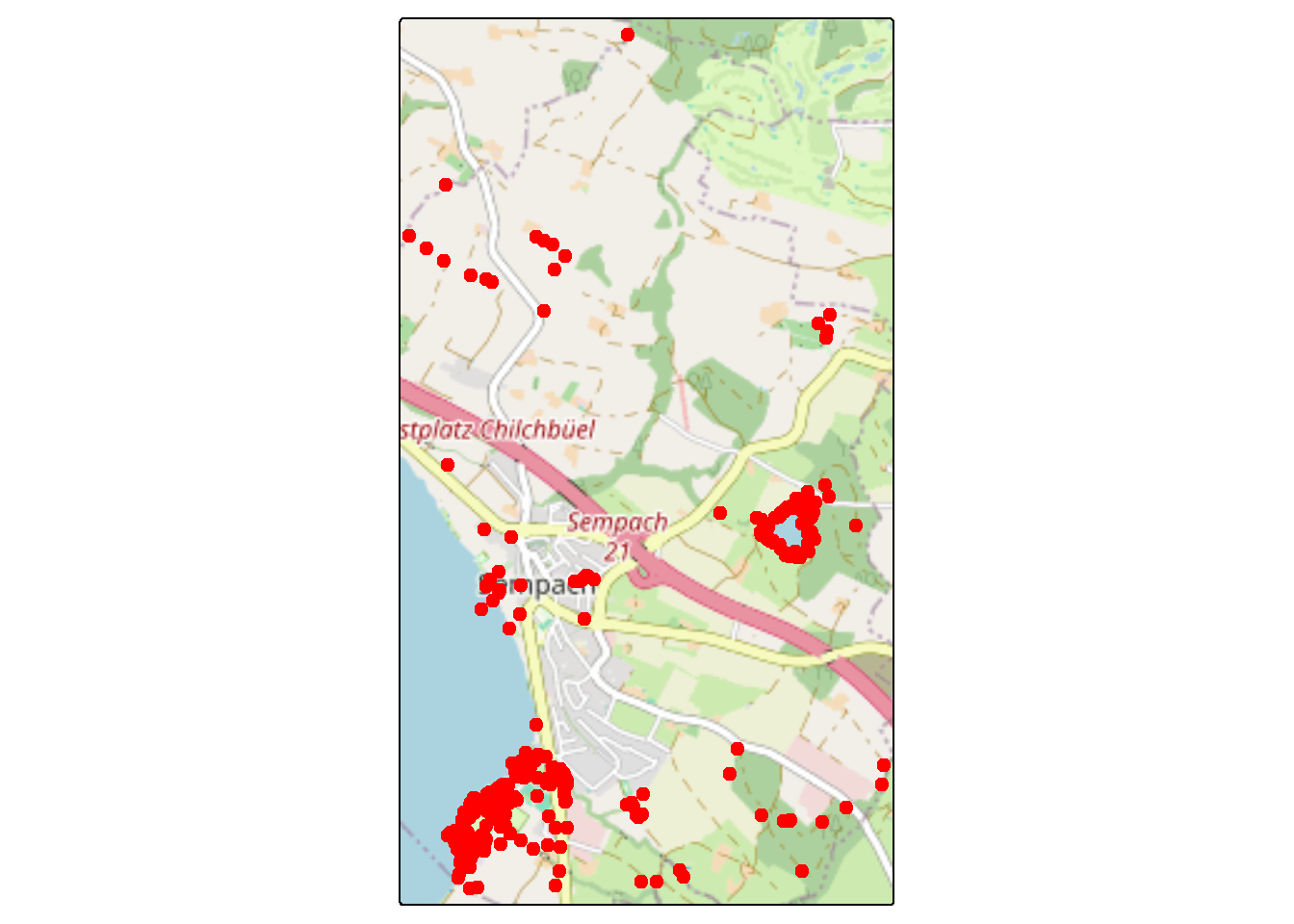
The next example is not a choropleth map, but it shows you another way to plot a continuous variable on a map. The argument values.scale inside the scaling function is used to scale the numerical values (otherwise the bubbles would be too small).
tm_shape(muni) + tm_borders() + tm_bubbles(size = "popsize",
size.scale = tm_scale(values.scale = 2))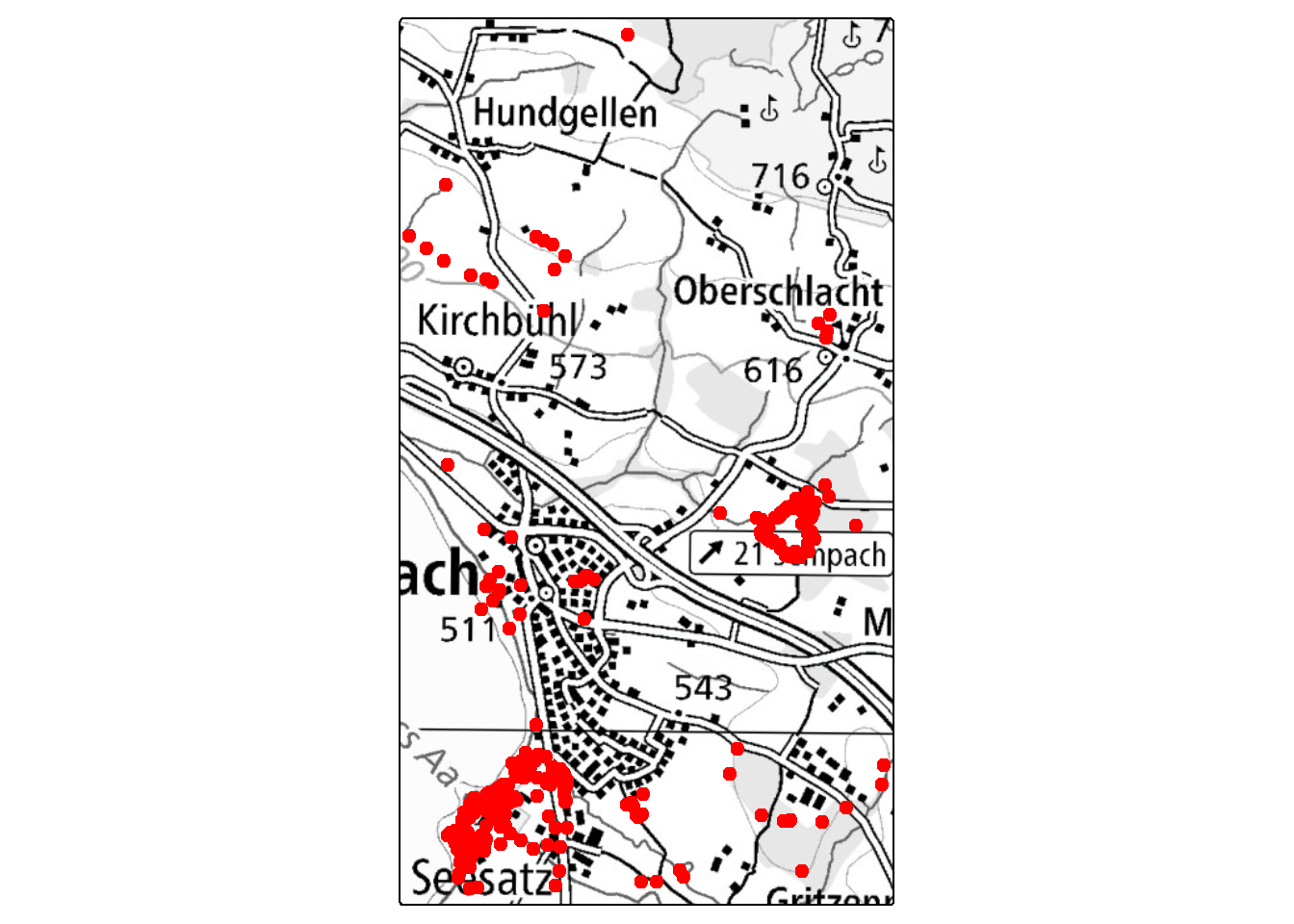
7.6.3 Customizing layout
We can include extra objects in our map, such as titles, scale bars or north arrows. Each element has a position argument. In the next example we also include some styling using the tm_style() function. Currently 9 styles are available (plus some old ones from tmap version 3). To list the available styles, run the tmap_style() function. You can also use the tmap_style_catalog() function to create sample maps using all the styles (the maps will be saved as PNG files in your working directory). We finally use the tm_layout() function to increase the right margin and draw a frame with sharp corners. For margins (specified as bottom, left, top, right), the units are relative to the map frame, so 0.05 means 5 percent of the frame height.
tm_shape(muni) + tm_polygons(fill = "popsize",
fill.legend = tm_legend(title = "Population size",
position = c("right", "top"),
frame = FALSE)) +
tm_compass(position = c("left", "bottom")) +
tm_scalebar(breaks = c(0, 1, 2, 3, 4), position = c("left", "bottom")) +
tm_title("Population size around Sempach", position = tm_pos_out("center", "top", "center")) +
tm_style("grey") +
tm_layout(inner.margins = c(0.05, 0.05, 0.05, 0.3), frame.r = 0)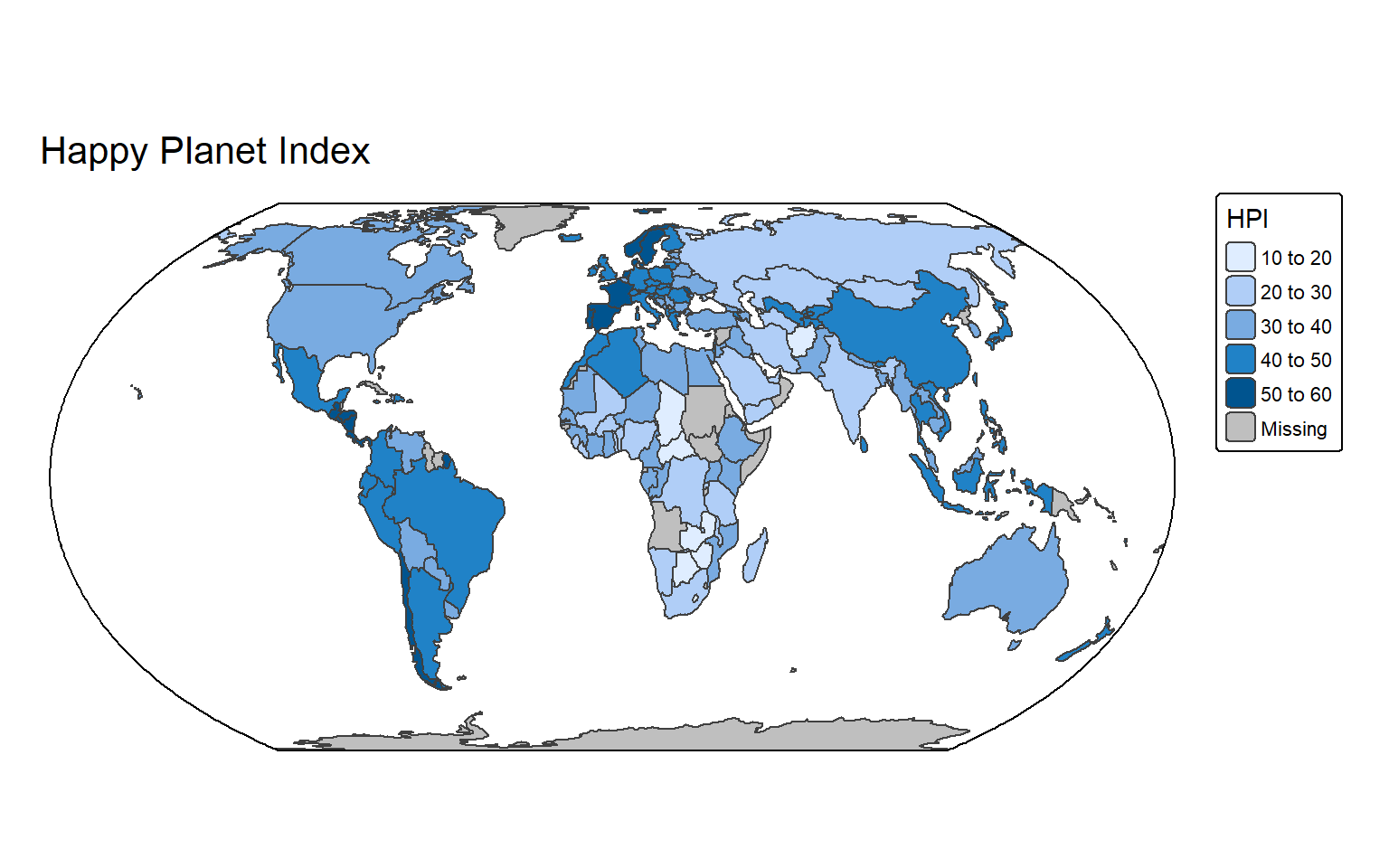
In the next example we customize two maps in the same plotting window. We also use the tm_title() function to add nicer titles and the tm_credits() function to add some copyright information. Note the difference when using lowercase vs. uppercase for the positioning of the map components. We also tell tmap to remove the automatic title panels using the panel.show = FALSE argument inside the tm_layout() function. Lastly, note how we change the colors and the title of the legends for the two maps using list objects, and the use of an expression to properly display the units.
tm_shape(muni) + tm_polygons(fill = c("popsize", "area"),
fill.scale = list(tm_scale(values = "brewer.reds"), tm_scale(values = "brewer.blues")),
fill.legend = list(tm_legend("Population size"), tm_legend(expression("Area [m"^2*"]")))) +
tm_title(c("Population size", "Area"), size = 1.1, position = c("right", "top")) +
tm_credits("Data © swisstopo", position = c("LEFT", "BOTTOM")) +
tm_layout(panel.show = FALSE)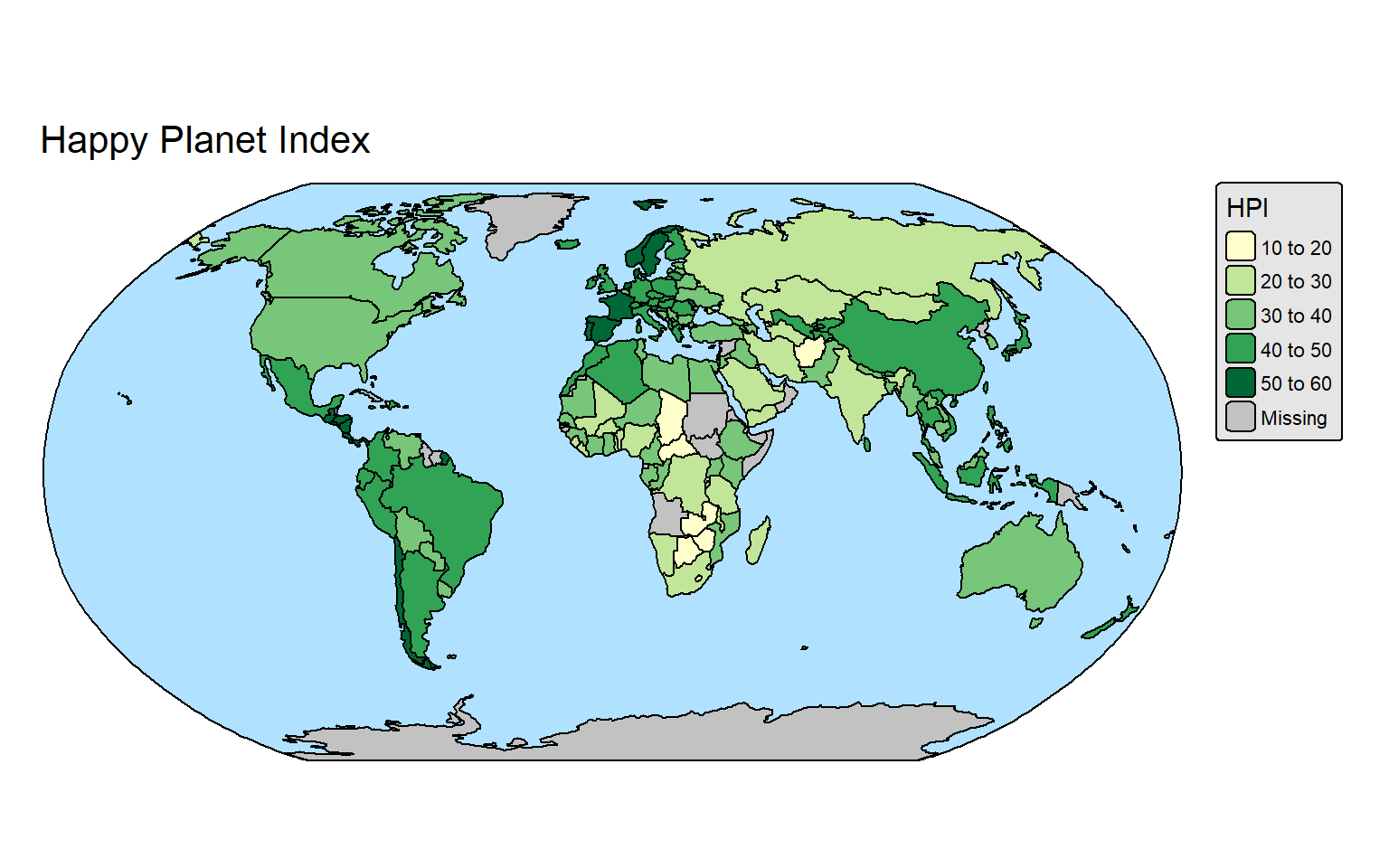
Having multiple maps on the same plot can be achieved using the tmap_arrange() function. First create your maps and store them in tmap objects, then use them with tmap_arrange(). This function is especially useful since the usual par(mfrow) trick doesn’t work with tmap objects.
map1 <- tm_shape(muni) + tm_polygons()
map2 <- tm_shape(sempach) + tm_polygons() + tm_shape(obs_in_sempach) + tm_dots()
map3 <- tm_shape(muni) + tm_polygons(fill = "popsize", fill.legend = tm_legend(position = c("left", "bottom"), frame = FALSE))
tmap_arrange(map1, map2, map3, nrow = 1)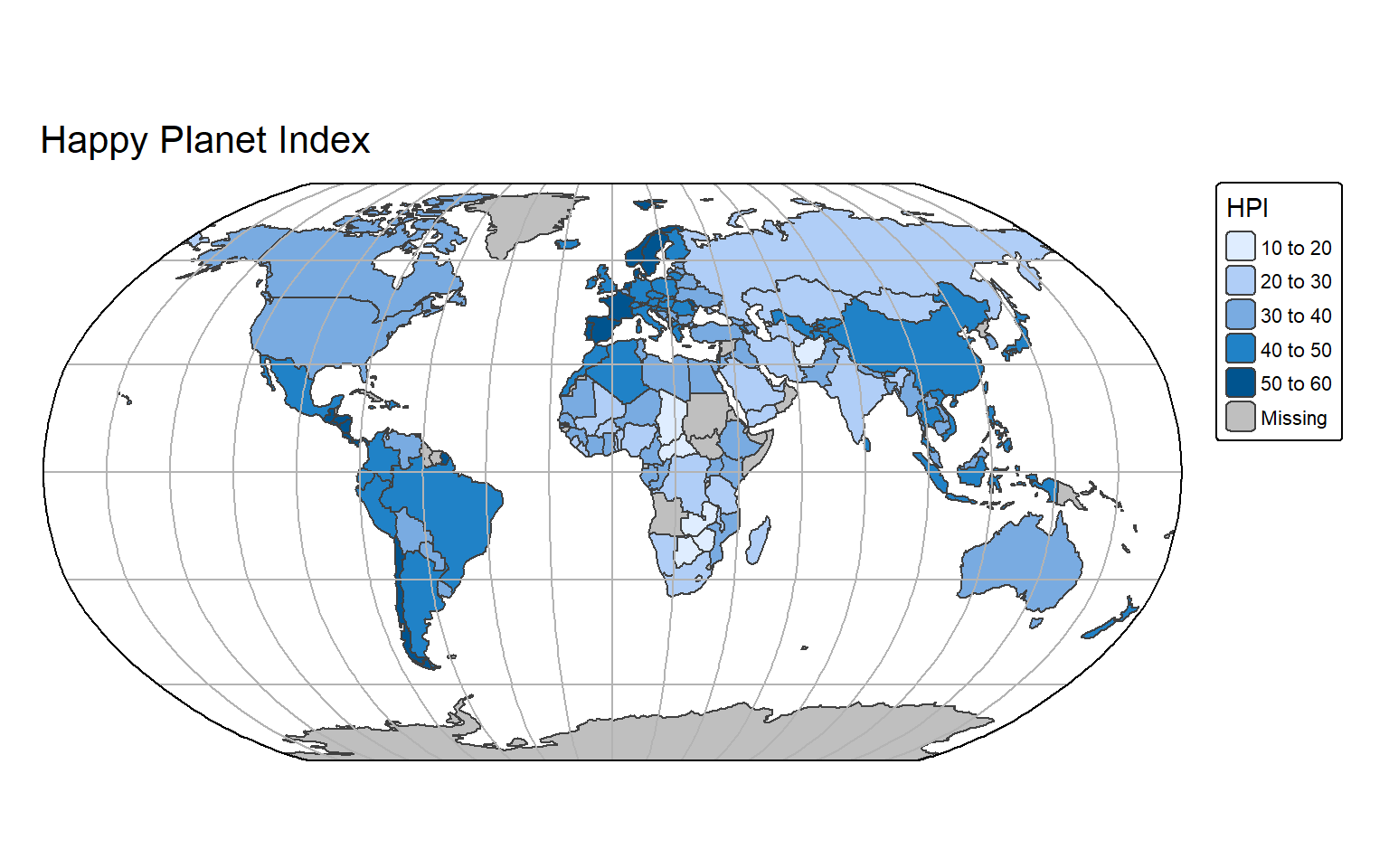
If you need multiple maps with a common legend, you should use the functions tm_facets_wrap() or tm_facets_stack(), depending on the layout you want. The function tm_facets() will decide which one to use automatically based on your data. In the next example we first generate a fake continuous attribute and then automatically create separate maps for each bird species, using the new attribute for the legend.
obs$var1 <- runif(nrow(obs), 1, 100)
tm_shape(obs) + tm_symbols(fill = "var1") + tm_facets_wrap("name")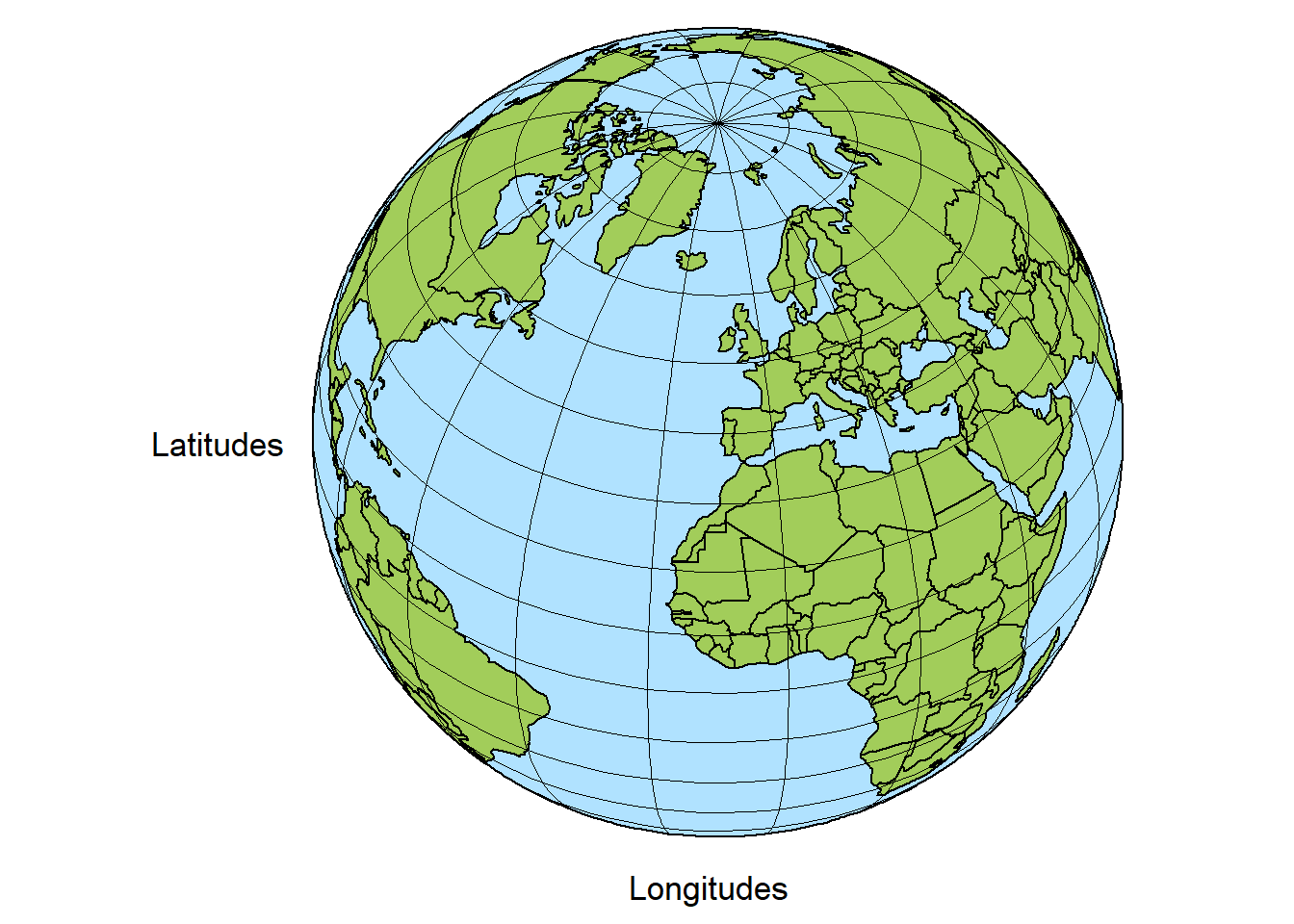
tm_shape(obs) + tm_symbols(fill = "var1") + tm_facets_stack("name")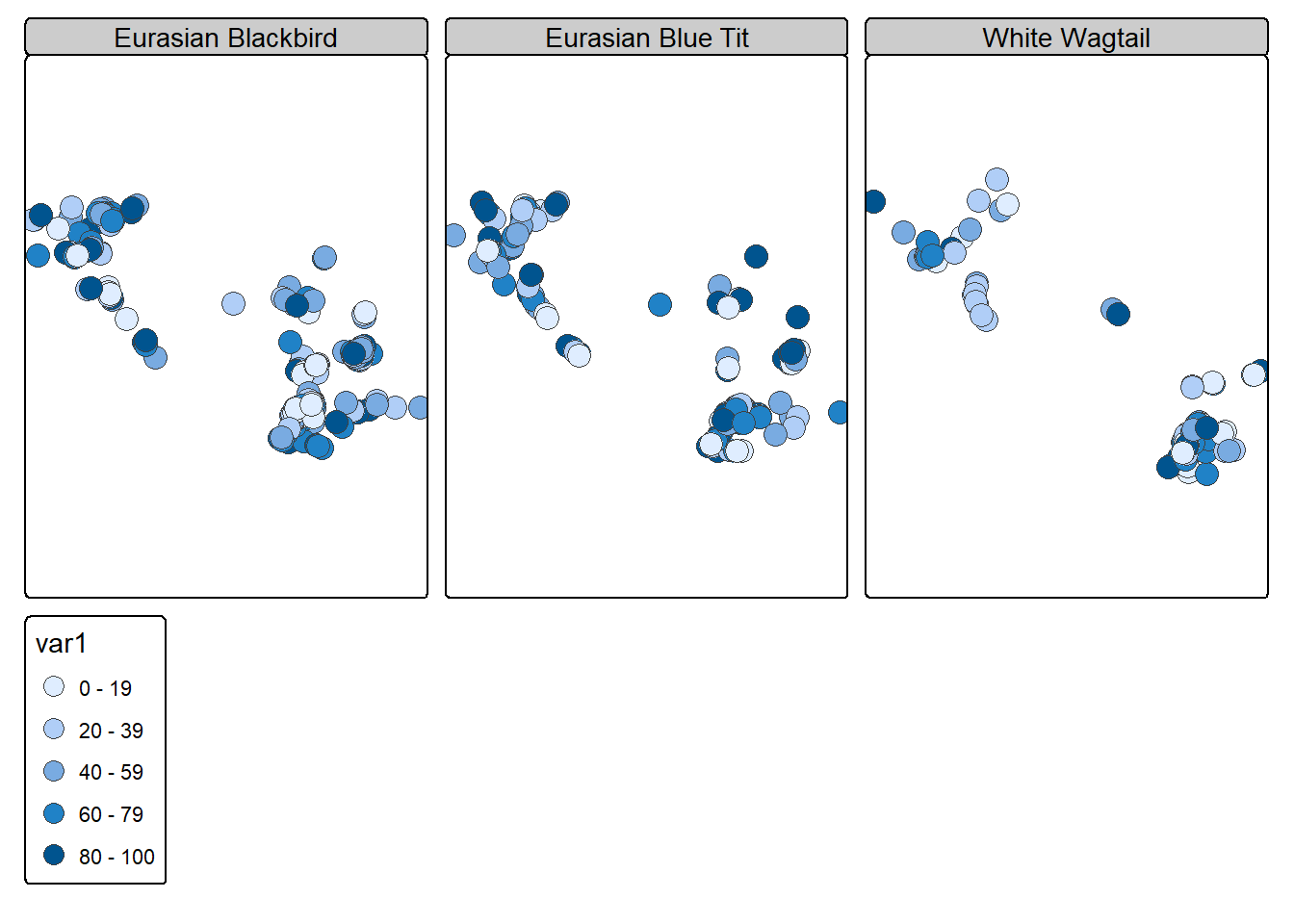
Facets can even be defined for two or three dimensions using the tm_facets_grid() function. Here’s how we can use it to create individual maps for two different variables and for each municipality.
tm_shape(muni) + tm_polygons(fill = c("popsize", "area")) + tm_facets_grid(columns = "name")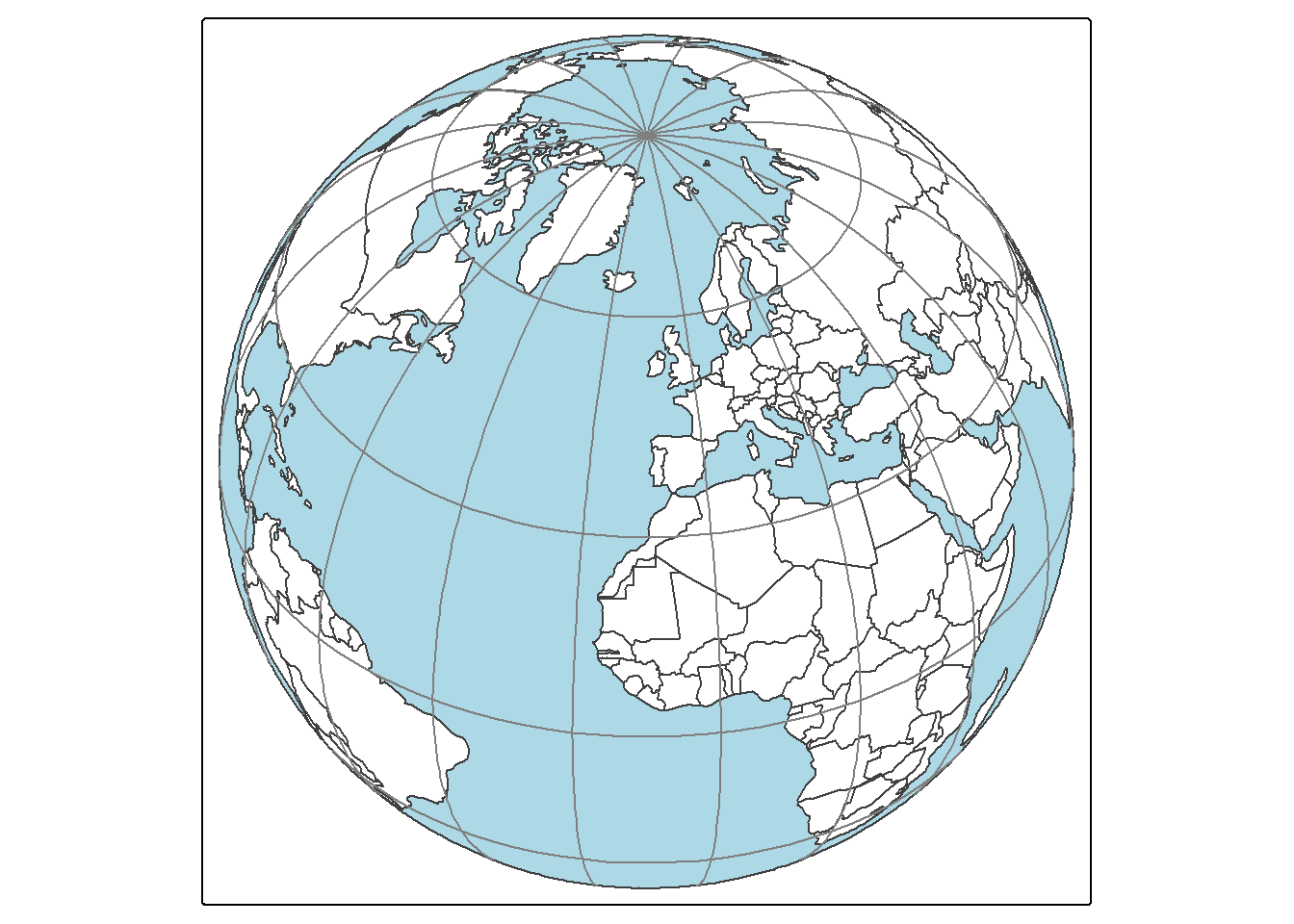
7.6.4 Basemaps
Adding a basemap to your map is extremely easy with tmap thanks to the tm_basemap() function. The maptiles package is used in the background to download the tiles. You only need to specify the provider name inside the tm_basemap() function, and you can adjust the zoom level with the zoom argument. Use the tmap_providers() function to get the list of available providers.
Creating a basemap and keeping it up to date is a lot of work! Please do not forget to cite it properly when you use some basemap.
Adding basemaps to static maps will work only with version 4.1 (or newer) of tmap.
map <- tm_shape(obs_in_sempach) + tm_dots(size = 0.5, fill = "red")
map + tm_basemap("OpenStreetMap")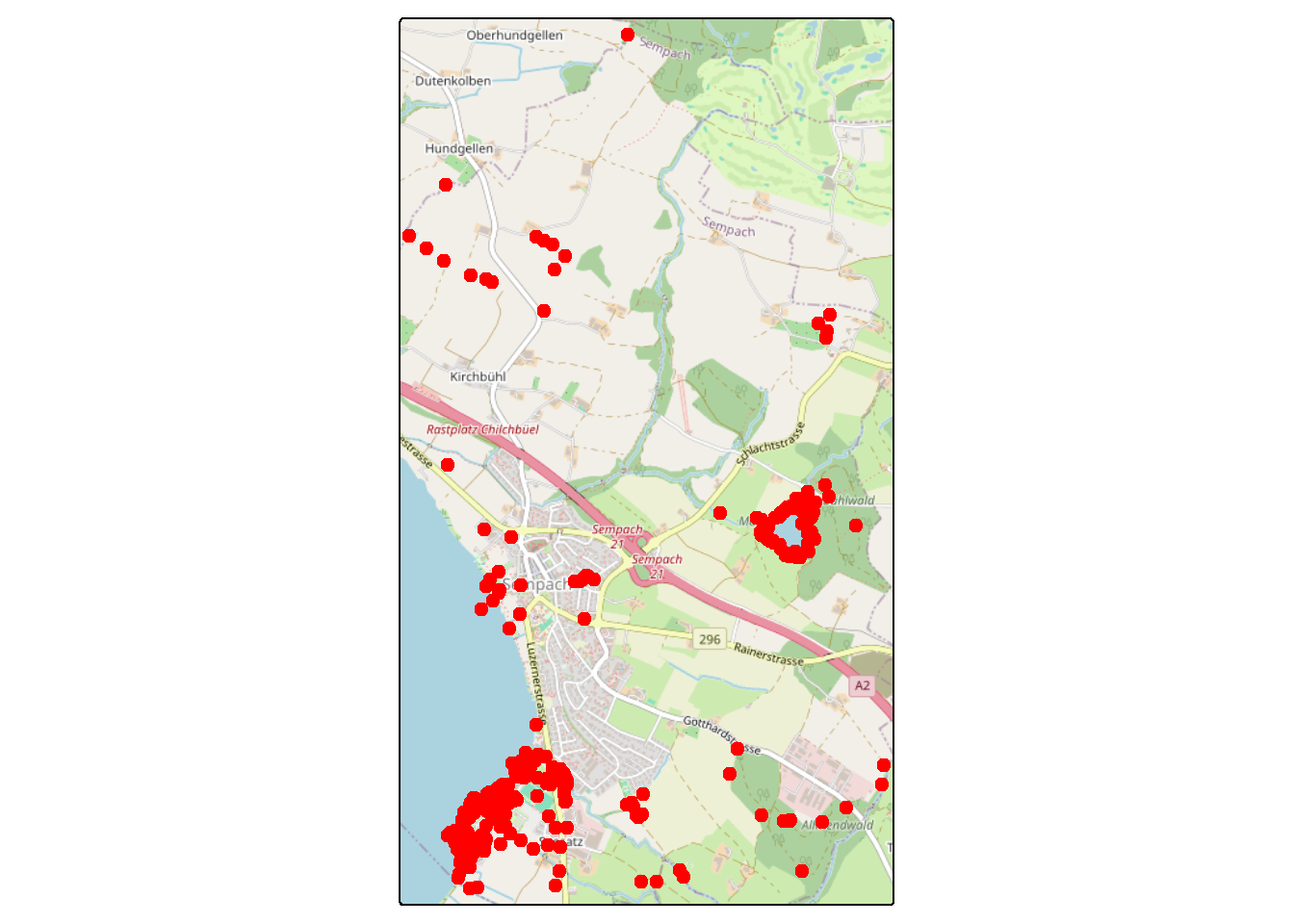
map + tm_basemap("OpenStreetMap", zoom = 13)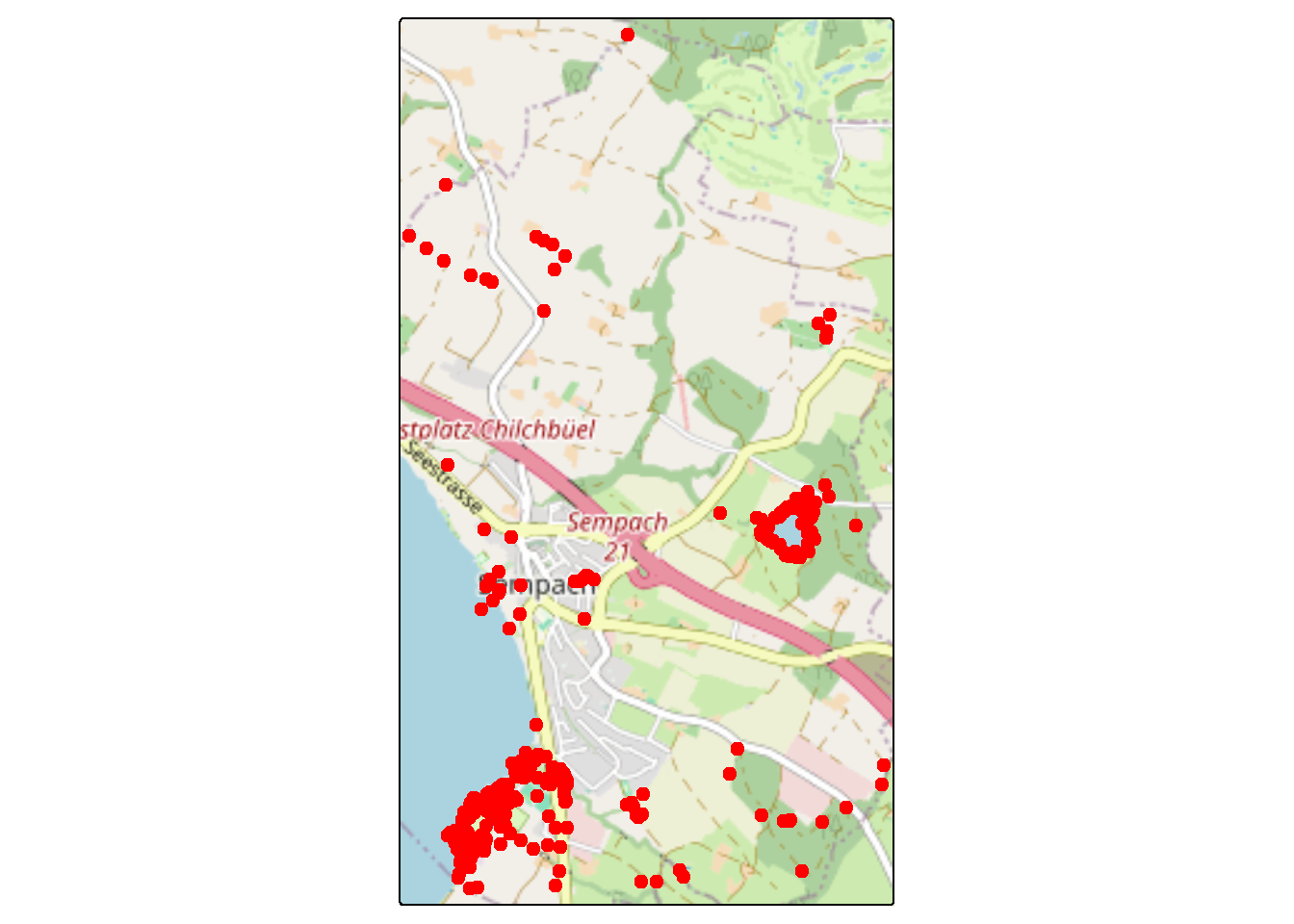
map + tm_basemap("CartoDB.Voyager")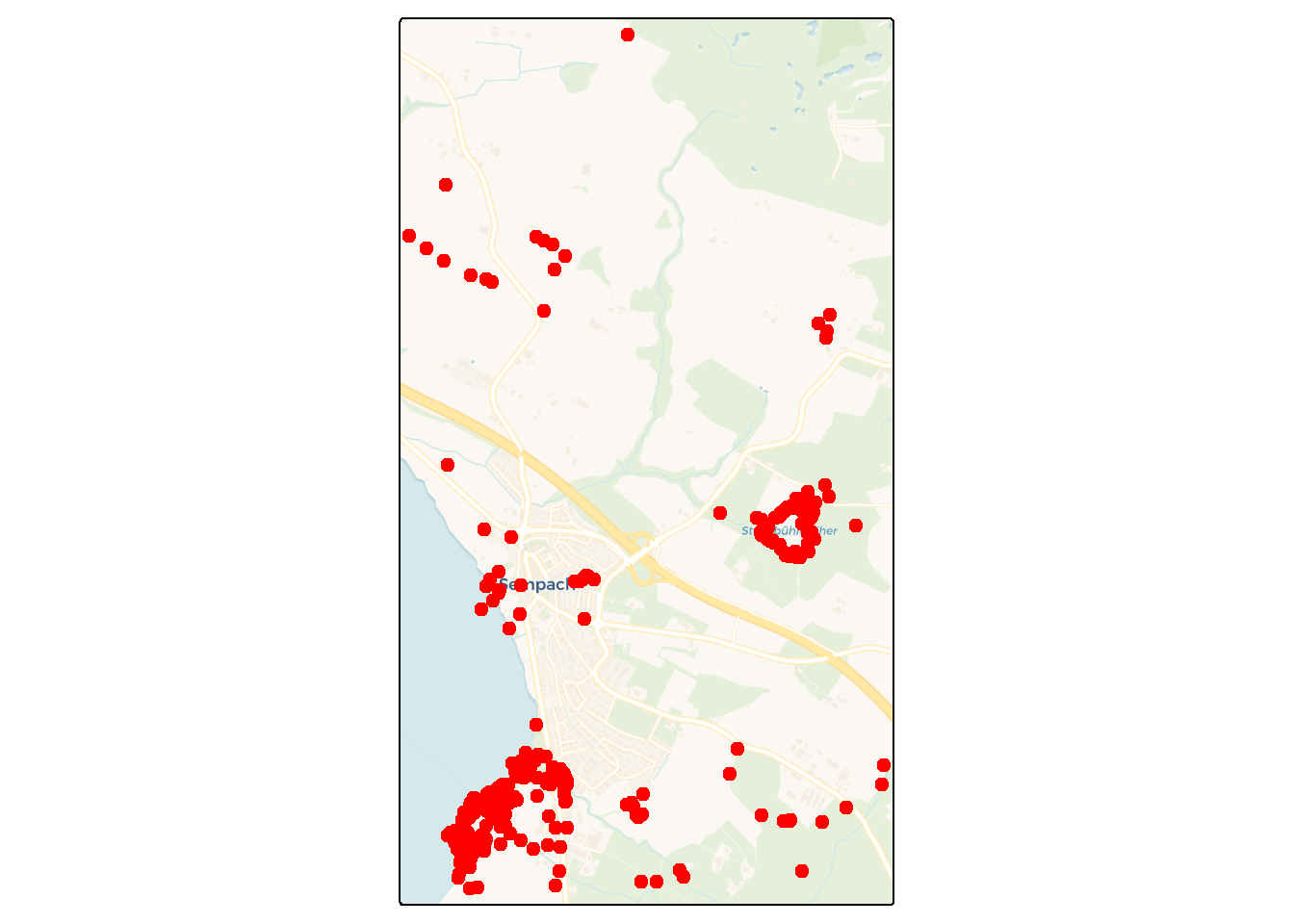
If you want to use another provider that is not included by default, you can directly use the URL of the tile server inside the tm_basemap() function. Note that the provider has to provide tiles using EPSG:3857 (it will not work with other CRSs). In the next example, we create maps combining bird sightings, topographic maps and imagery from Swisstopo.
map + tm_basemap(server = "https://wmts.geo.admin.ch/1.0.0/ch.swisstopo.pixelkarte-grau/default/current/3857/{z}/{x}/{y}.jpeg")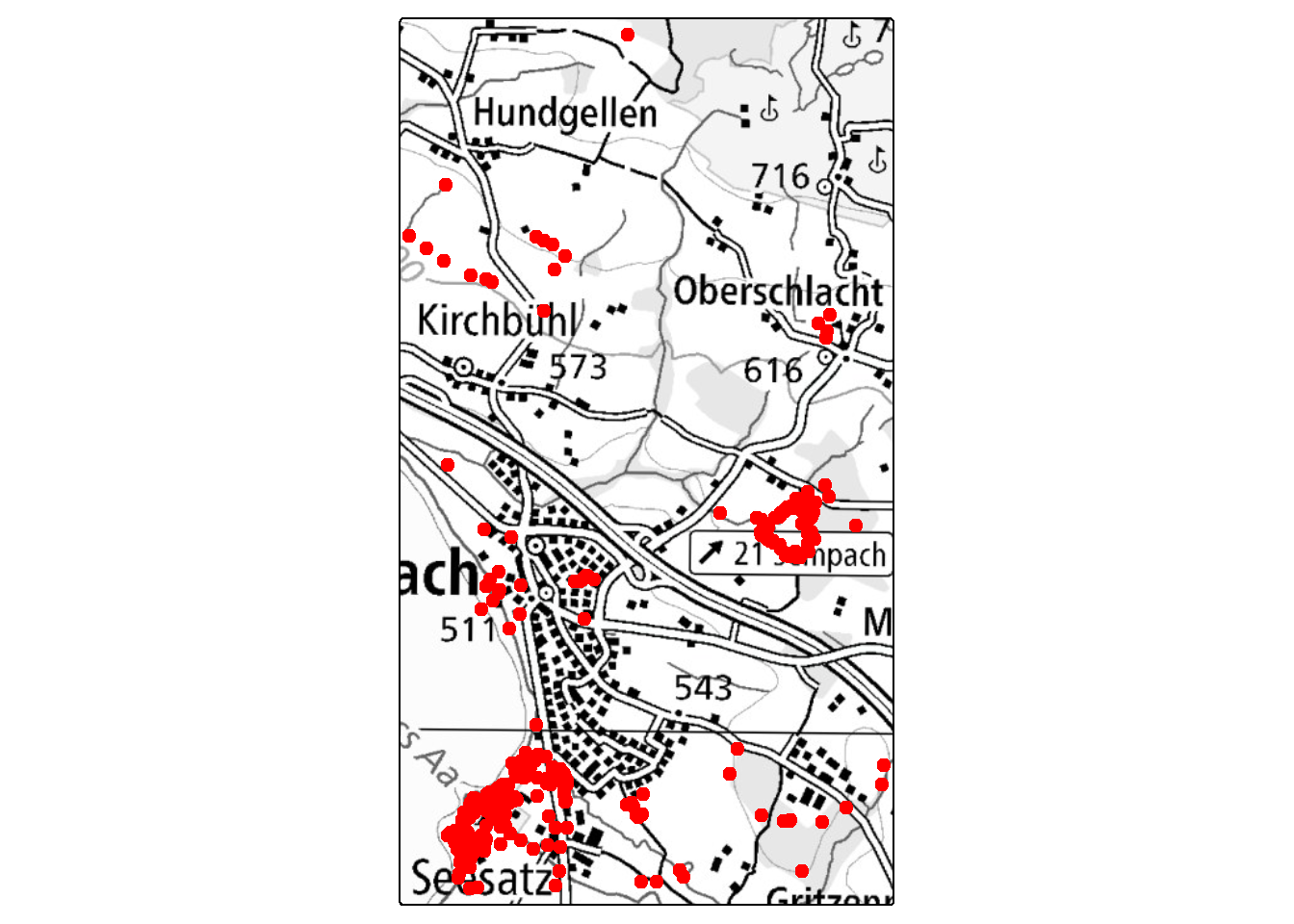
map + tm_basemap(server = "https://wmts.geo.admin.ch/1.0.0/ch.swisstopo.pixelkarte-farbe/default/current/3857/{z}/{x}/{y}.jpeg")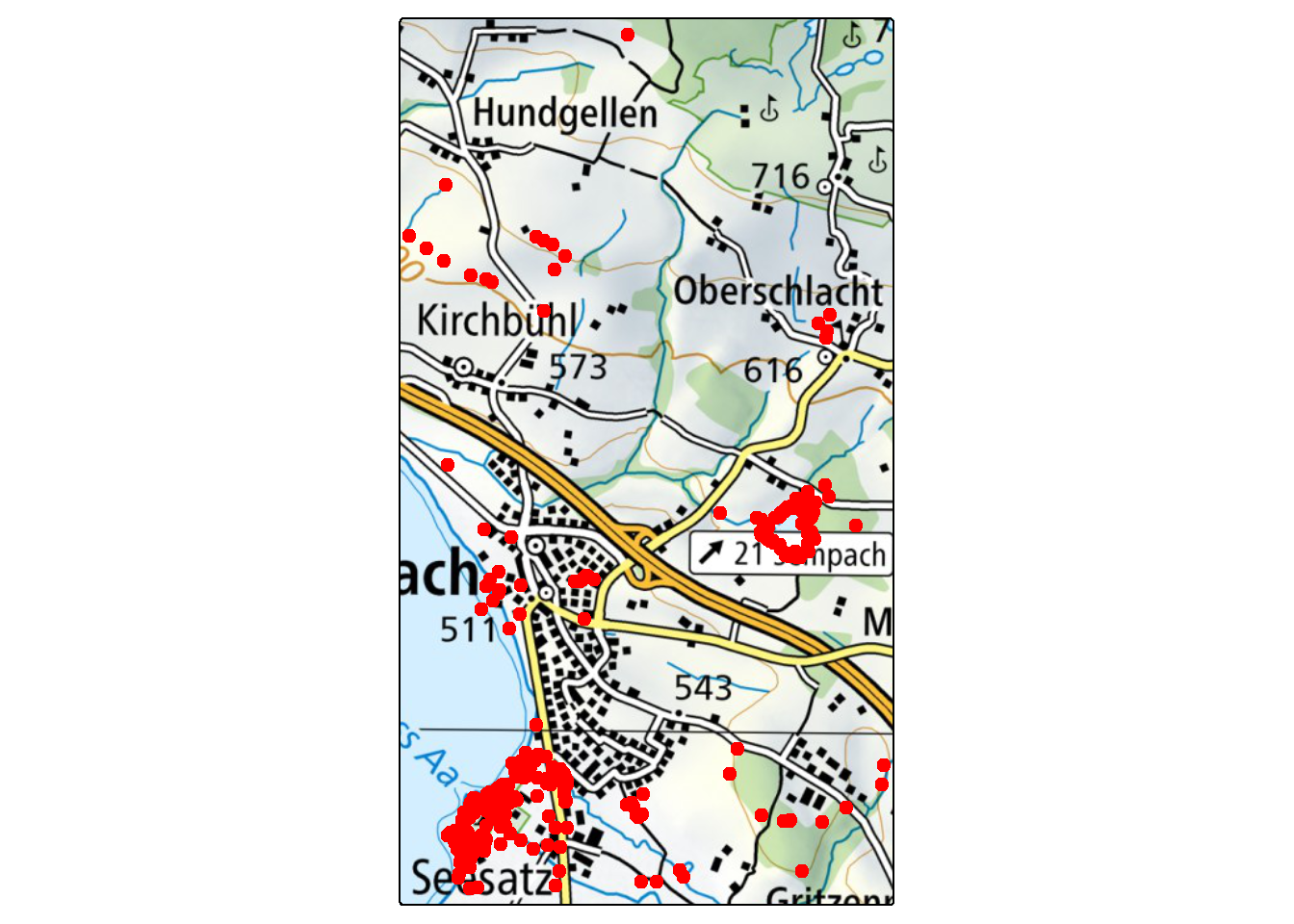
map + tm_basemap(server = "https://wmts.geo.admin.ch/1.0.0/ch.swisstopo.swissimage/default/current/3857/{z}/{x}/{y}.jpeg")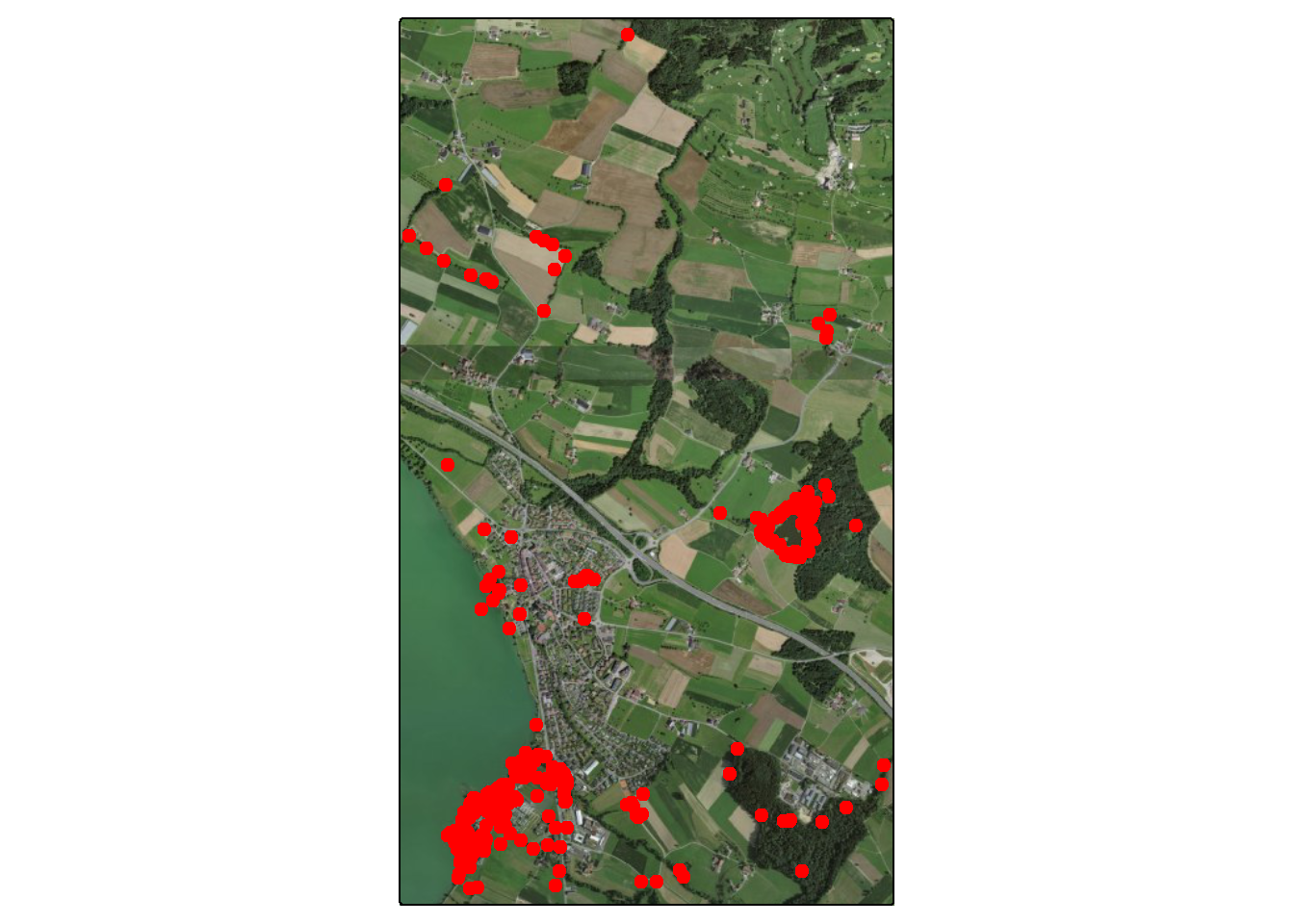
When using data from Swisstopo with tmap, you will notice that the grid lines on the topographic maps won’t appear as straight perpendicular lines. This is caused by the reprojection of the original maps to EPSG:3857 on the Swisstopo server. The orthophotos also have some strange display artefacts.
7.6.5 World maps and globes
The default projection that is used to plot data with a geographic CRS in tmap is the same as before. We’ve seen that it’s not ideal since the distortions are large (especially near the poles) and the map will appear elongated.
tm_shape(World) + tm_polygons("HPI") +
tm_title("Happy Planet Index")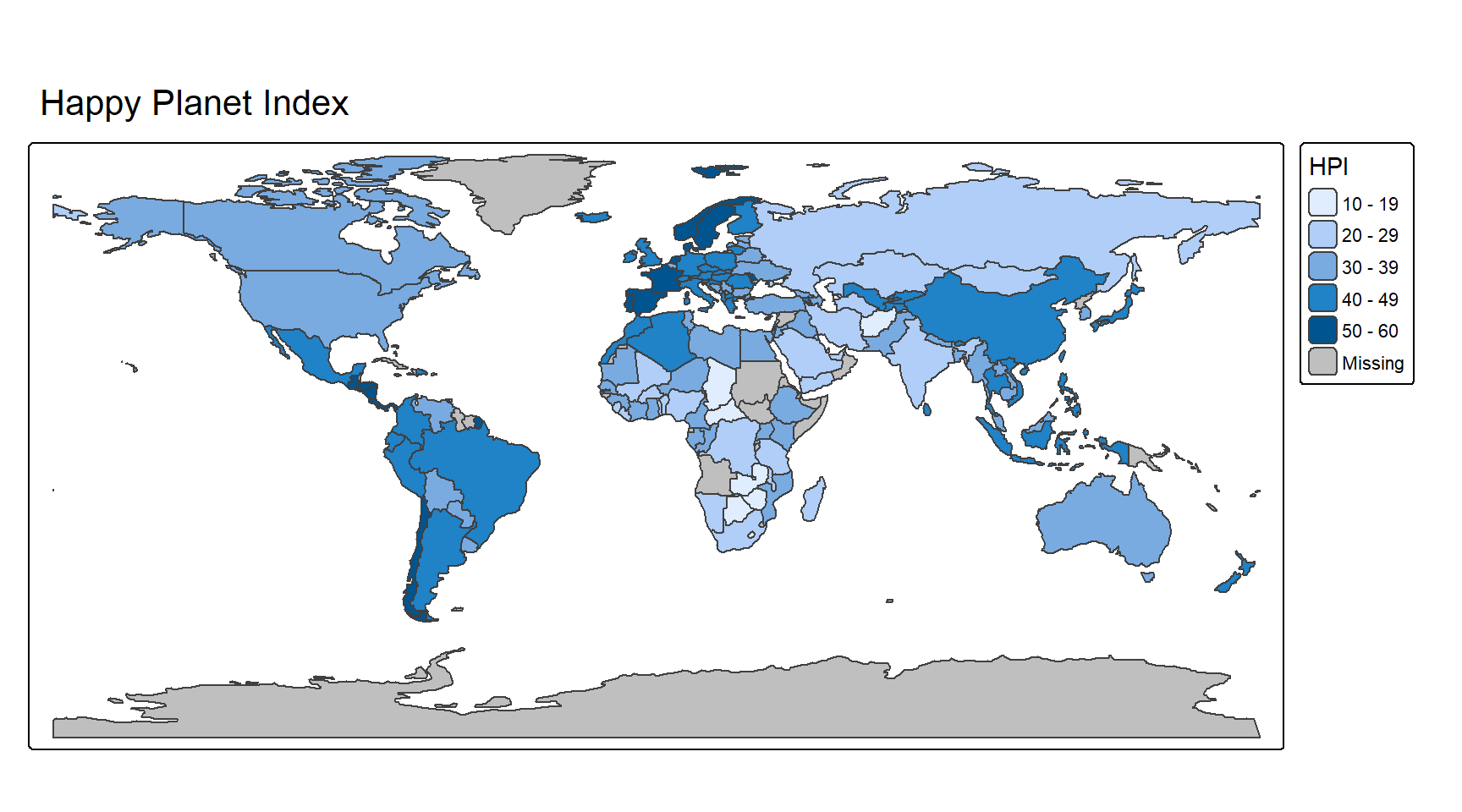
As in the previous section, I recommend using either the Robinson projection, which was designed to be aesthetically pleasing, or the Equal-Earth projection, which has the advantage of having equal areas. The Winkel tripel projection can also be a good choice. With tmap, you can use the tm_crs() function to define the projection that will be applied to the map. For world maps, you can use the argument earth_boundary = TRUE inside the tm_layout() function to display the earth boundary (this is only available for a few global projections, such as the ones we’re using). We also remove the map frame using frame = FALSE.
map <- tm_shape(World) + tm_polygons(fill = "HPI") +
tm_title("Happy Planet Index") +
tm_layout(earth_boundary = TRUE, frame = FALSE)
# Equal-Earth
map + tm_crs("EPSG:8857")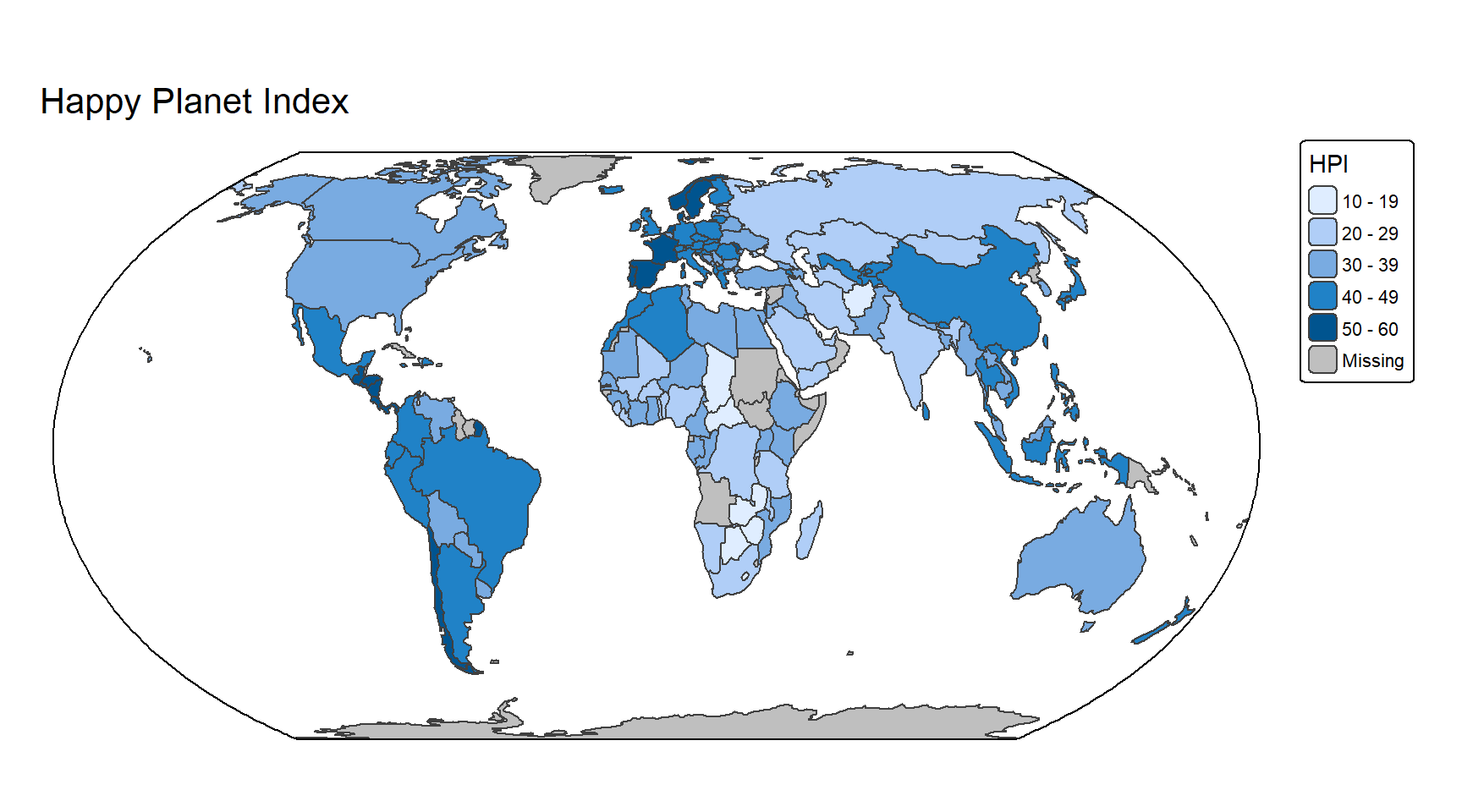
# Robinson
map + tm_crs("ESRI:54030")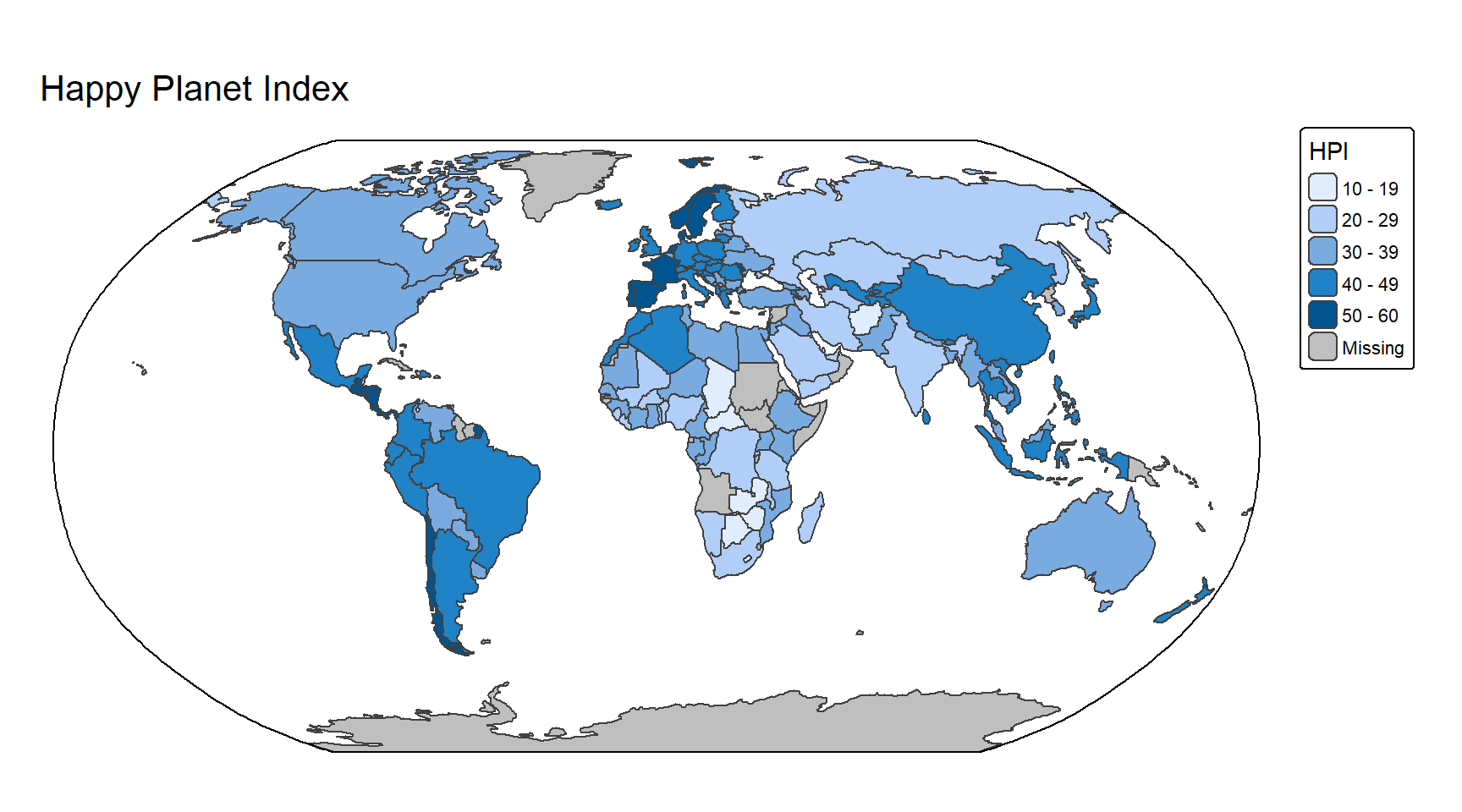
# Winkel tripel
map + tm_crs("+proj=wintri")
You probably remember my warning about proj4strings, and that you should not use them for projections. I’m actually using one of these strings here to define the Winkel tripel projection. The main reason is that there is no EPSG (or ESRI) number for this CRS. Moreover, for global maps, the inaccuracies are negligible.
You can also use the tm_style("natural") function to specify a style adapted for world maps. Here’s an example using the Robinson projection.
tm_shape(World) + tm_polygons(fill = "HPI") +
tm_style("natural") +
tm_title("Happy Planet Index") +
tm_layout(earth_boundary = TRUE, frame = FALSE) +
tm_crs("ESRI:54030")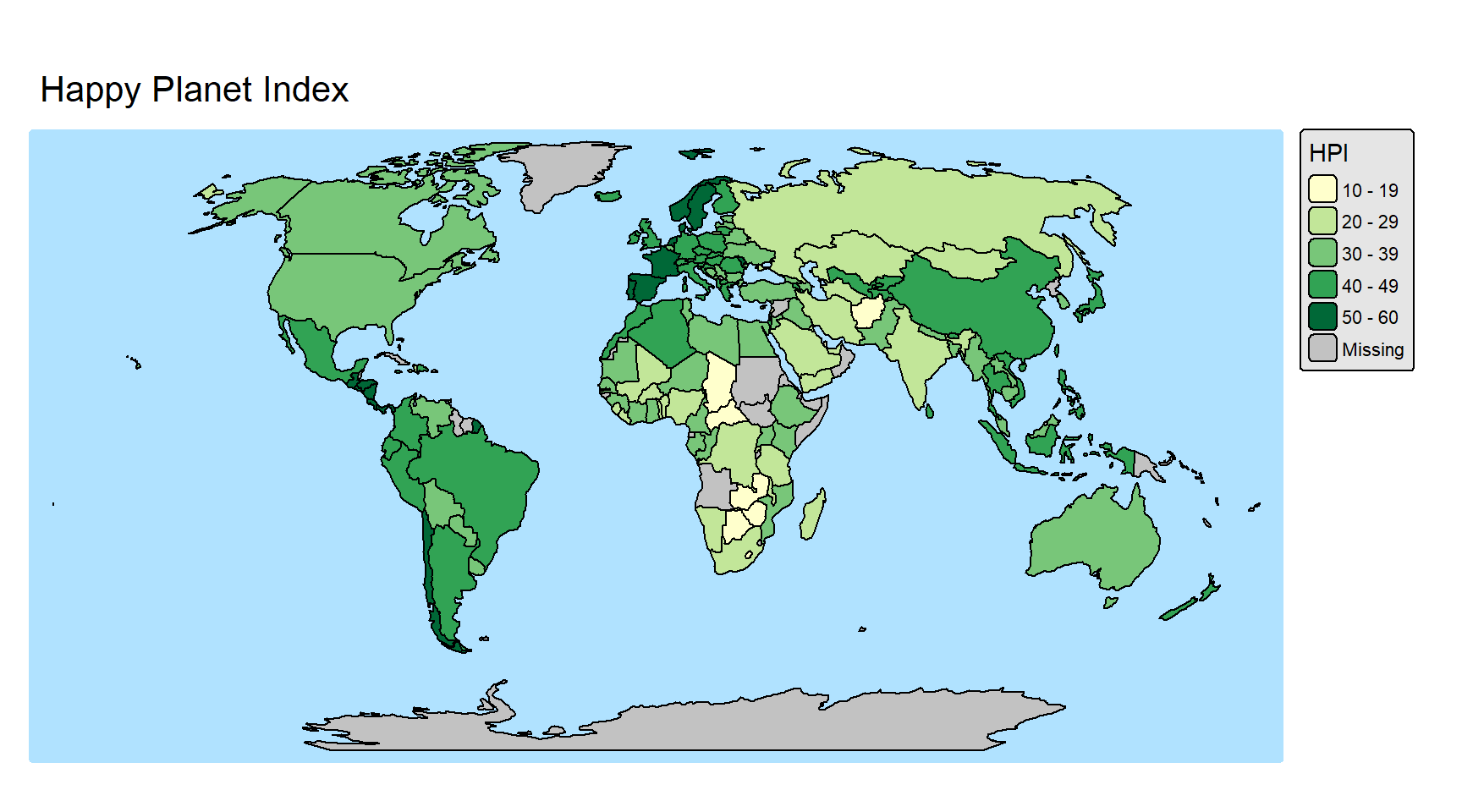
You can easily add graticule lines to your world map. We first need to generate them using the st_graticule() function (from the sf package). In theory you could use the tmap function tm_graticules() but unfortunately, depending on the projection, the lines don’t go all the way to the poles.
grat <- st_graticule(lon = seq(-180, 180, by = 20), lat = seq(-90, 90, by = 30))
tm_shape(World) +
tm_polygons(fill = "HPI") +
tm_shape(grat) +
tm_lines(col = "grey70") +
tm_title("Happy Planet Index") +
tm_layout(earth_boundary = TRUE, frame = FALSE) +
tm_crs("ESRI:54030")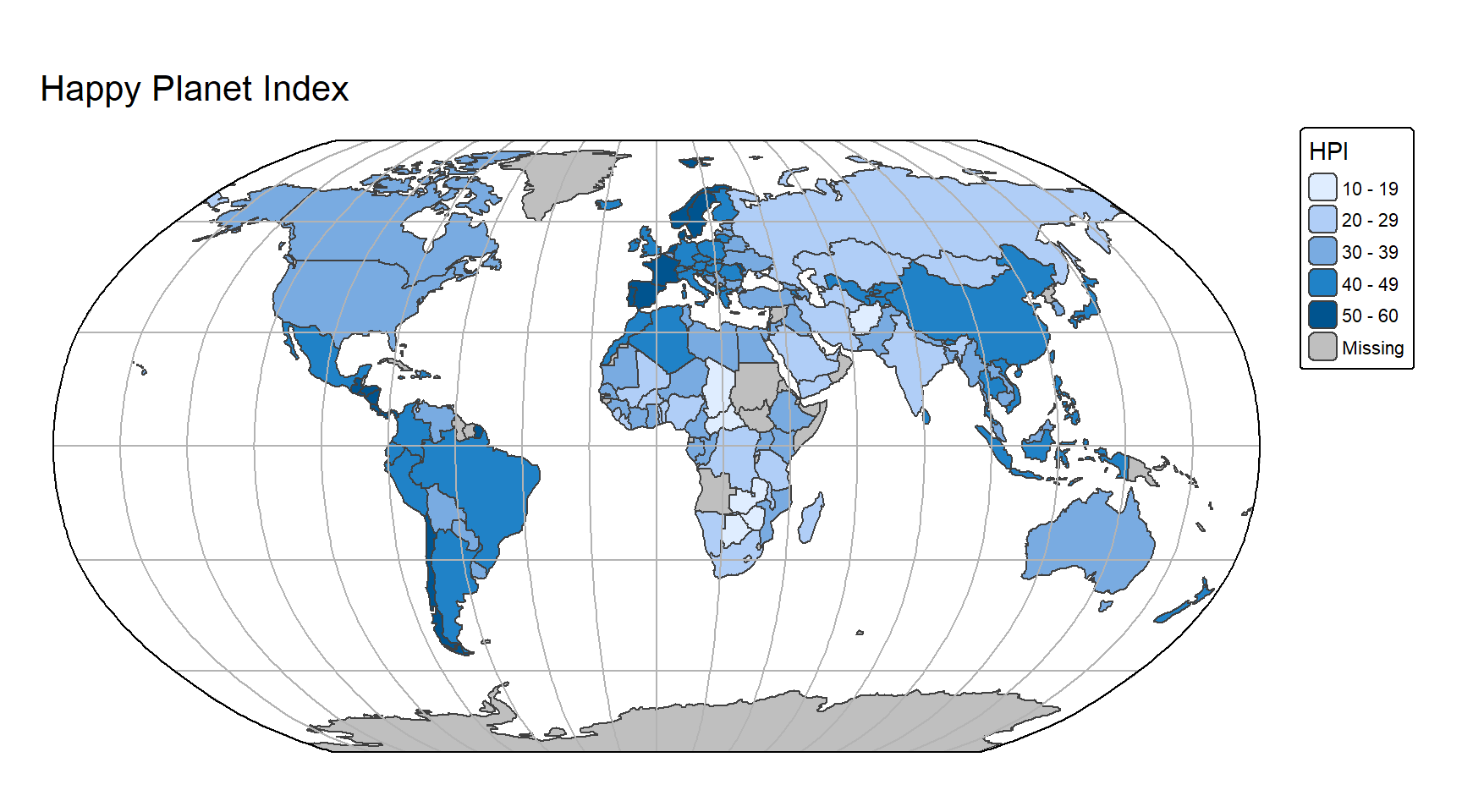
If you want to plot a 2D globe, you can use the orthographic projection (which is also using a proj4string). You can center the globe on one point by modifying the lat_center and lon_center variables in the following code.
lat_center <- 40
lon_center <- -10
projstring <- paste0("+proj=ortho +lat_0=", lat_center, " +lon_0=", lon_center)
tm_shape(World) +
tm_polygons(fill = "white") +
tm_graticules(n.x = 20, n.y = 10, col = "black", lwd = 0.5, labels.show = FALSE) +
tm_crs(projstring, bbox = "FULL") +
tm_layout(bg.color = "lightblue", earth_boundary = TRUE) +
tm_xlab("Longitudes", size = 1.1) + tm_ylab("Latitudes", size = 1.1)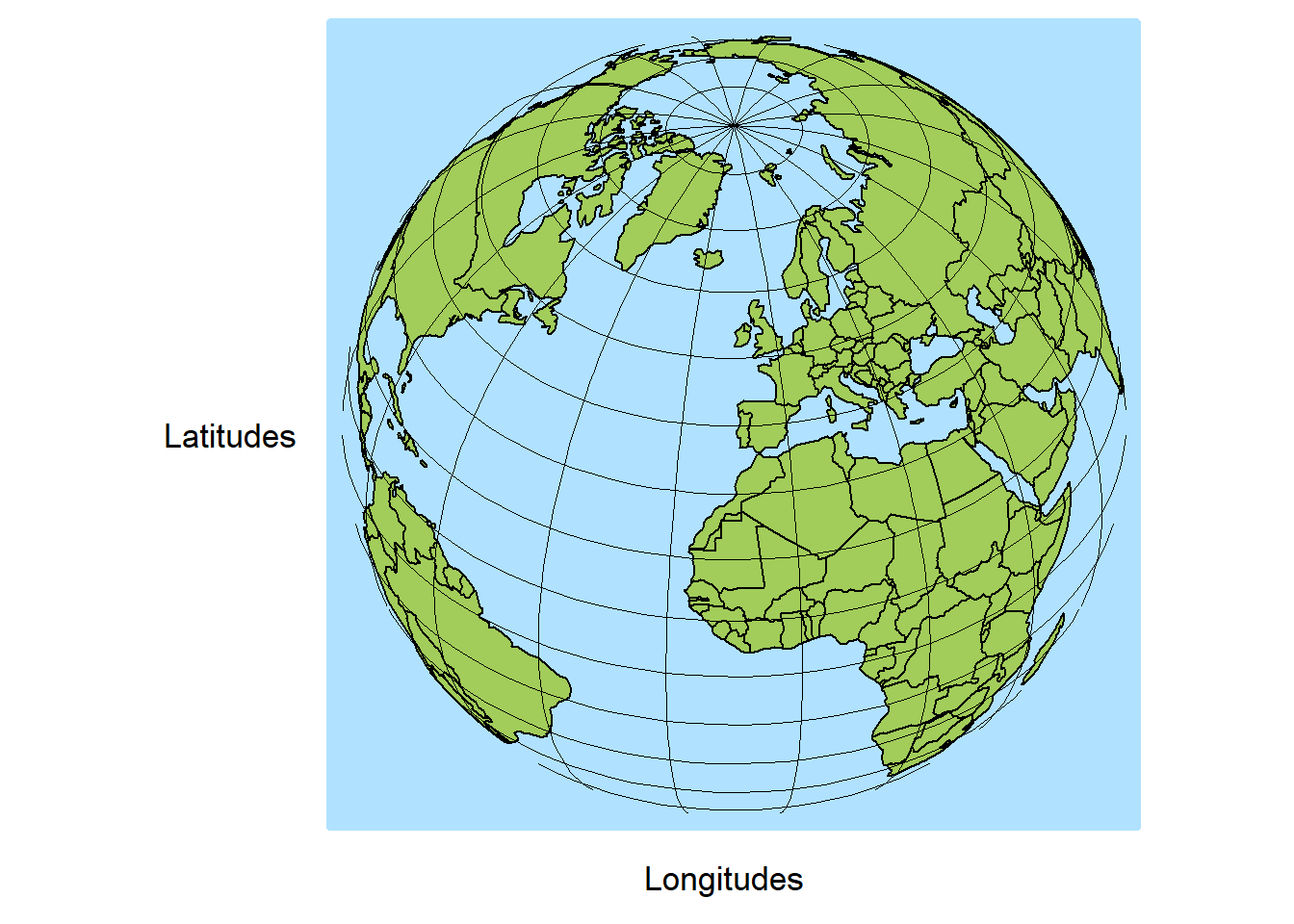
Or you can use the code we used in the previous section to create the data, but this time we will use tmap to plot everything.
options(s2_oriented = TRUE) # don't change orientation of the geometries (since the orientation is already correct)
earth <- st_as_sfc("POLYGON FULL", crs = "EPSG:4326")
# If you specify the first argument (x = earth), some lines will be missing after clipping
grat <- st_graticule(lon = seq(-180, 180, by = 20), lat = seq(-90, 90, by = 30))
countries <- st_as_sf(s2_data_countries())
oceans <- st_difference(earth, st_union(countries))
# Clip the data using the visible half (otherwise problems can happen with the orthographic projection, for example countries with vertices in the non-visible part will disappear)
buff <- st_buffer(st_as_sfc(paste0("POINT(", lon_center, " ", lat_center, ")"), crs = "EPSG:4326"), 9800000) # visible half
countries_clipped <- st_intersection(buff, countries)
oceans_clipped <- st_intersection(buff, oceans)
grat_clipped <- st_intersection(buff, grat)
tm_shape(oceans_clipped) +
tm_polygons(fill = "lightblue") +
tm_shape(countries_clipped) +
tm_borders() +
tm_shape(grat_clipped) +
tm_lines(col = "grey50") +
tm_crs(projstring)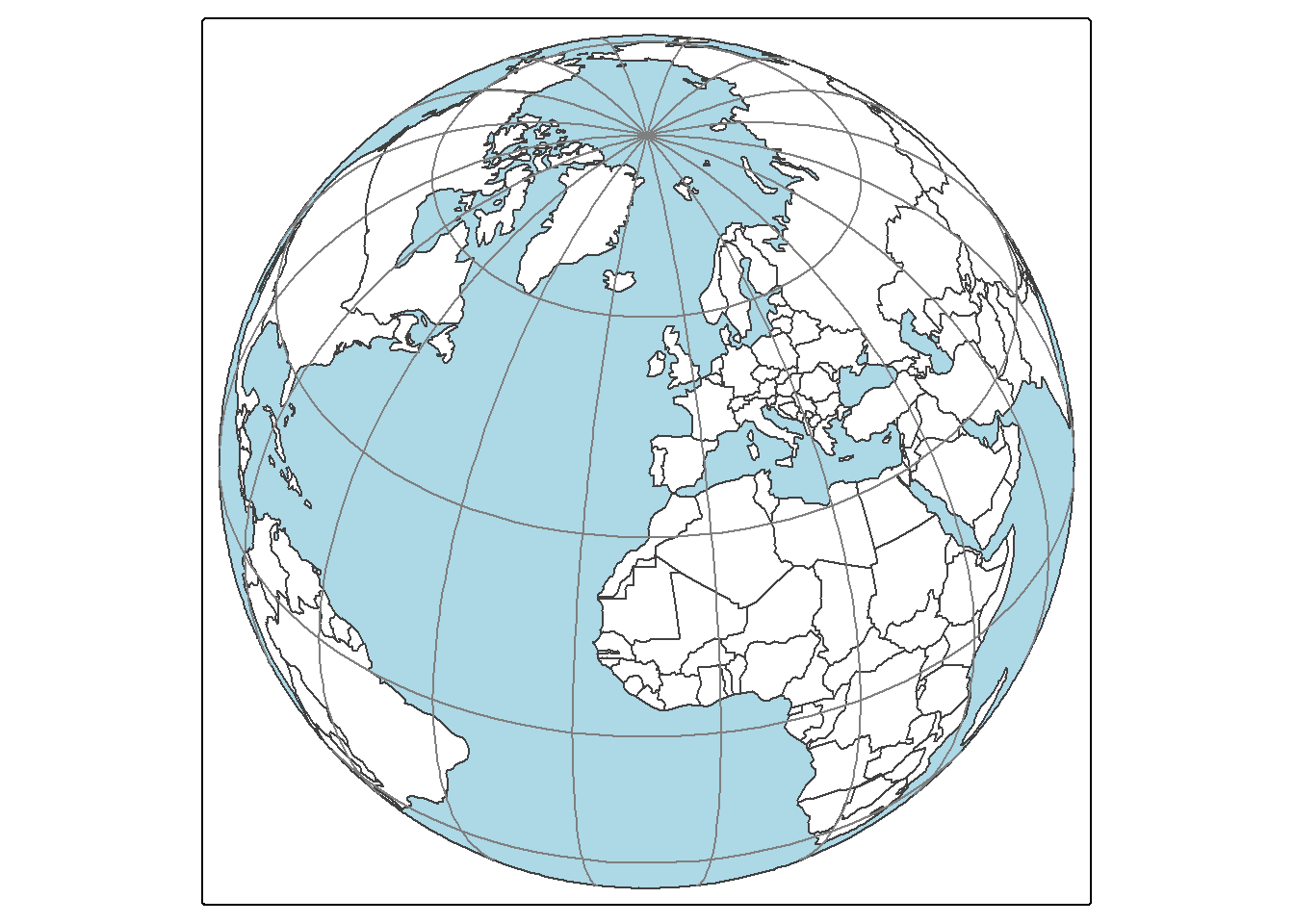
7.6.6 Saving maps
Saving maps is trivially easy using the tmap_save() function. The format is automatically recognized using the file name extension. You can also specify the height, width and resolution of the map.
map1 <- tm_shape(muni) + tm_polygons()
tmap_save(map1, "mymap.png")7.7 mapsf
On the to-do list…